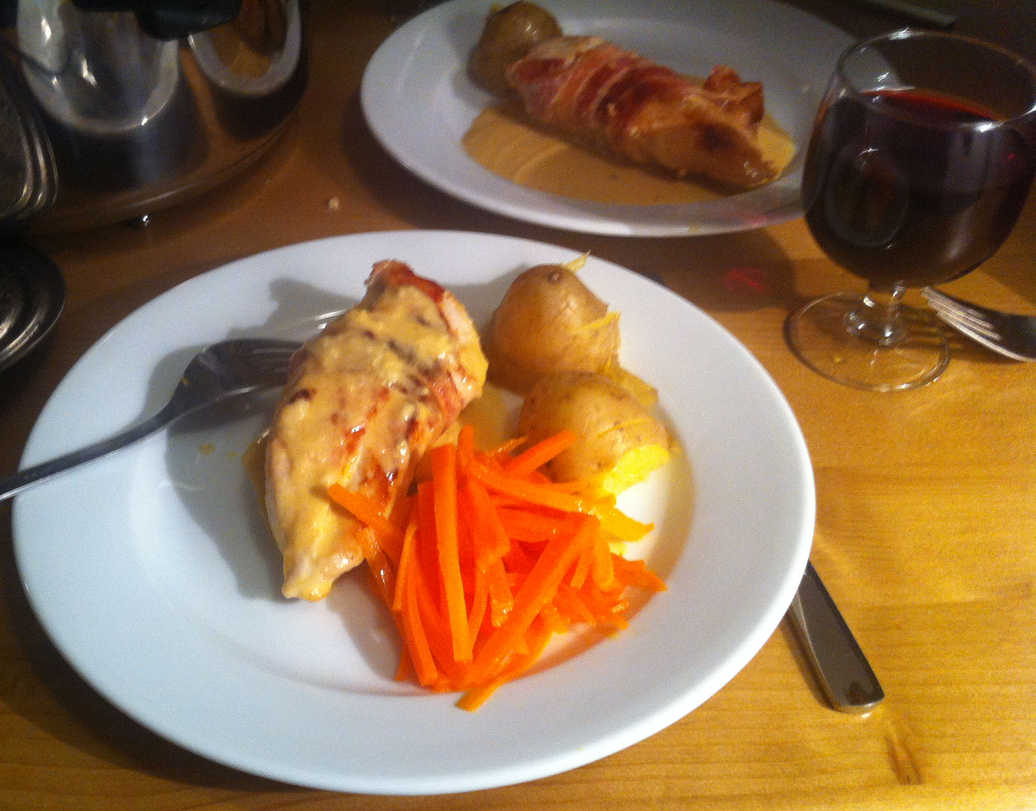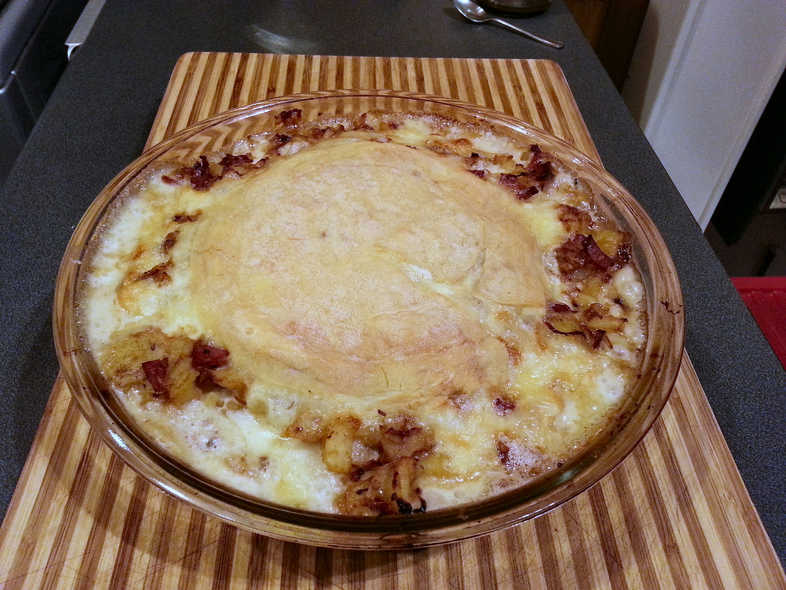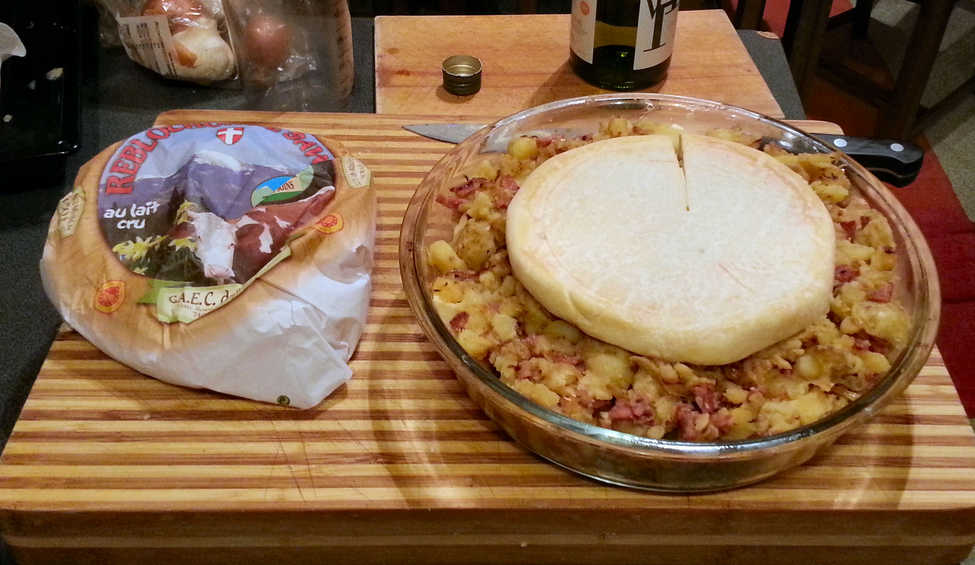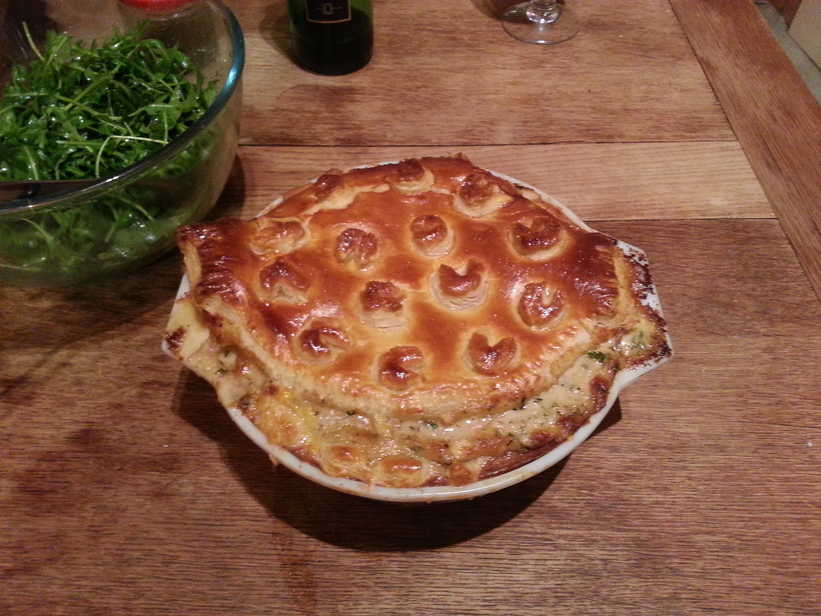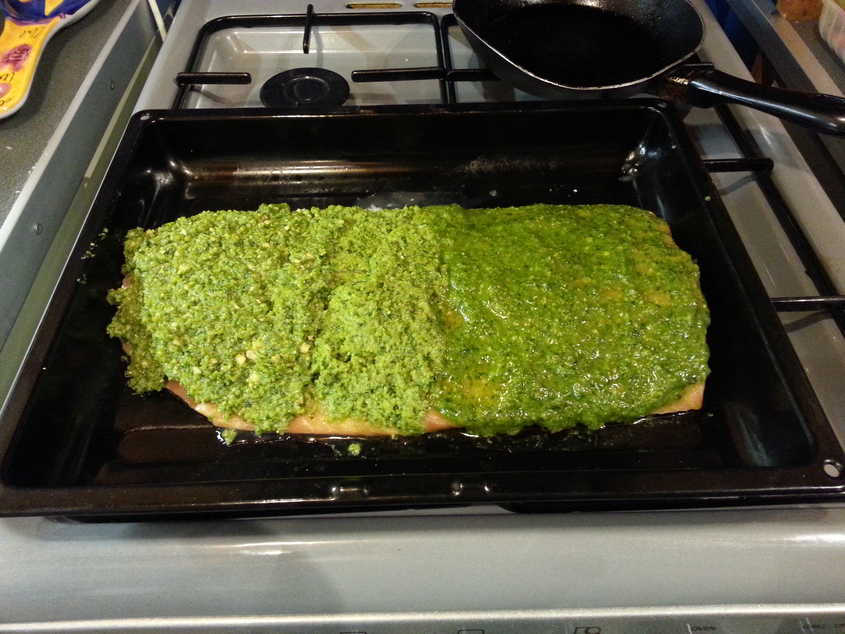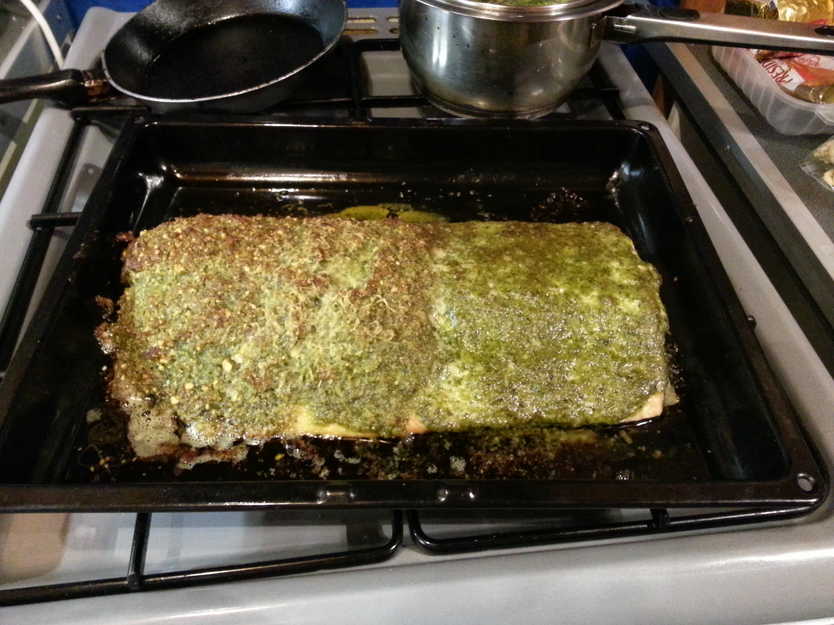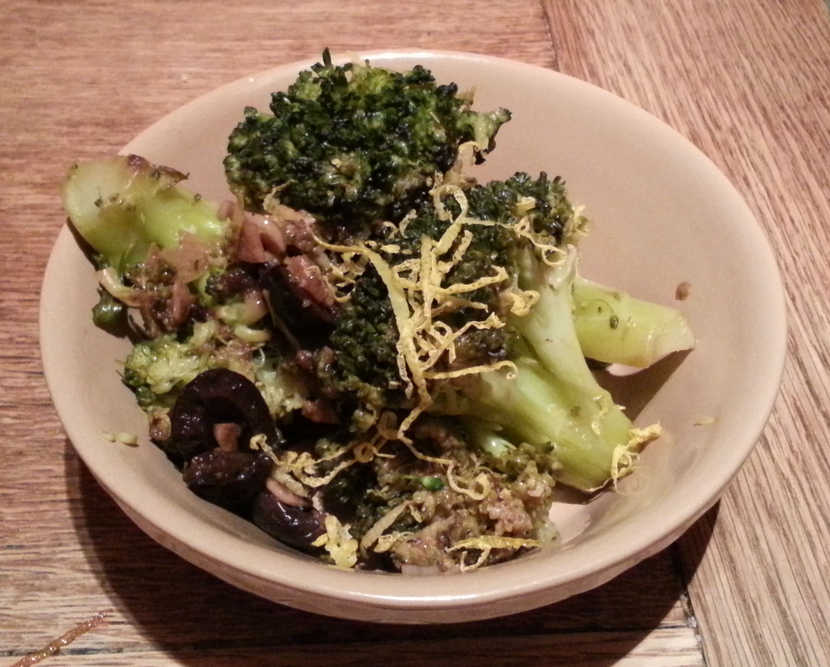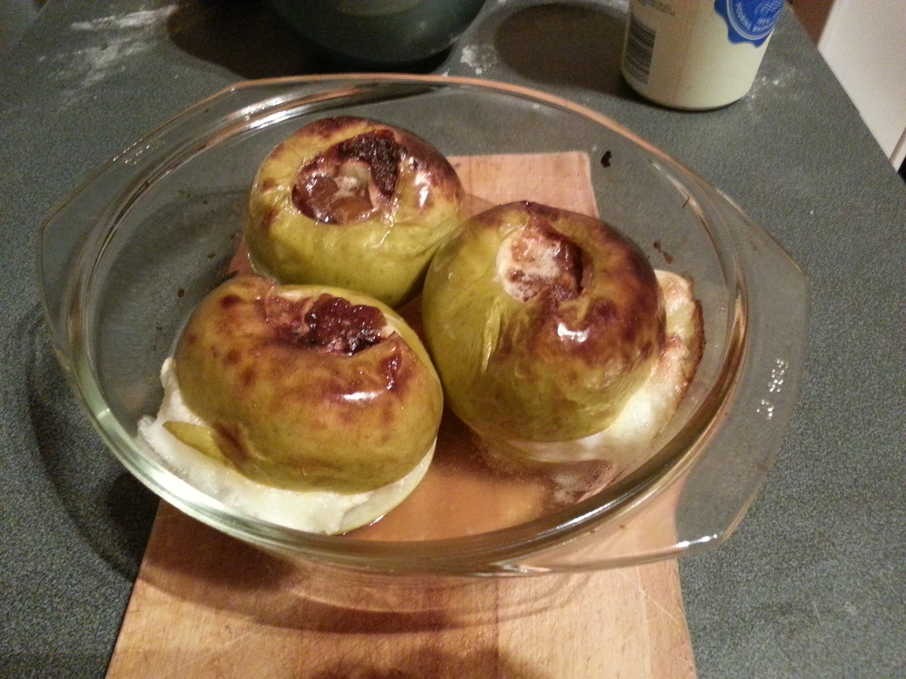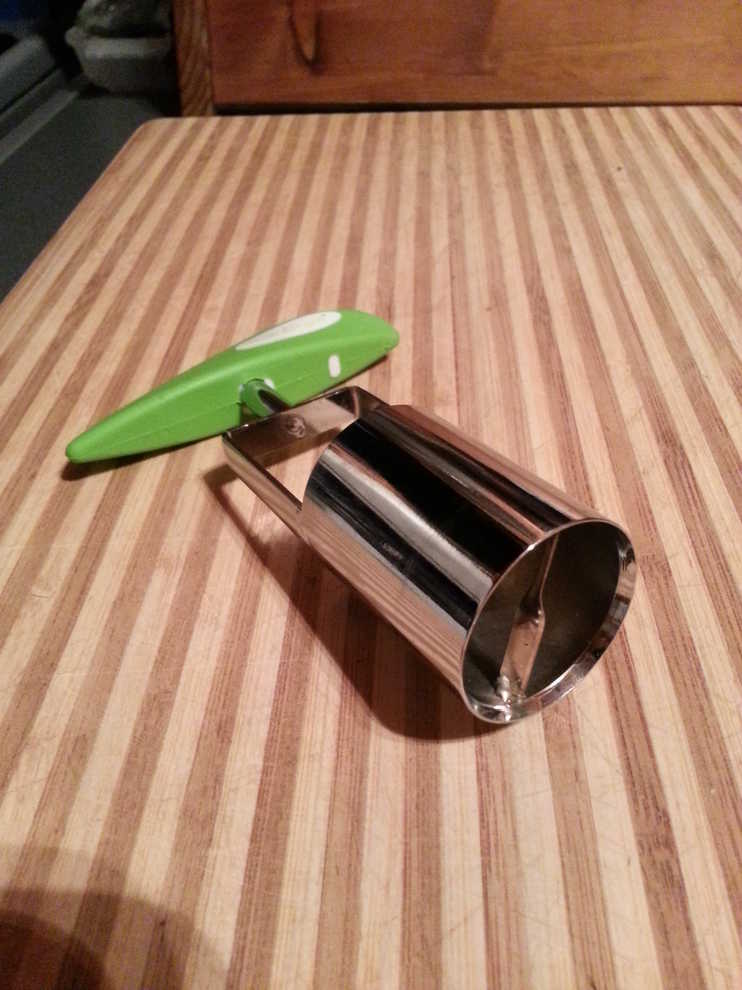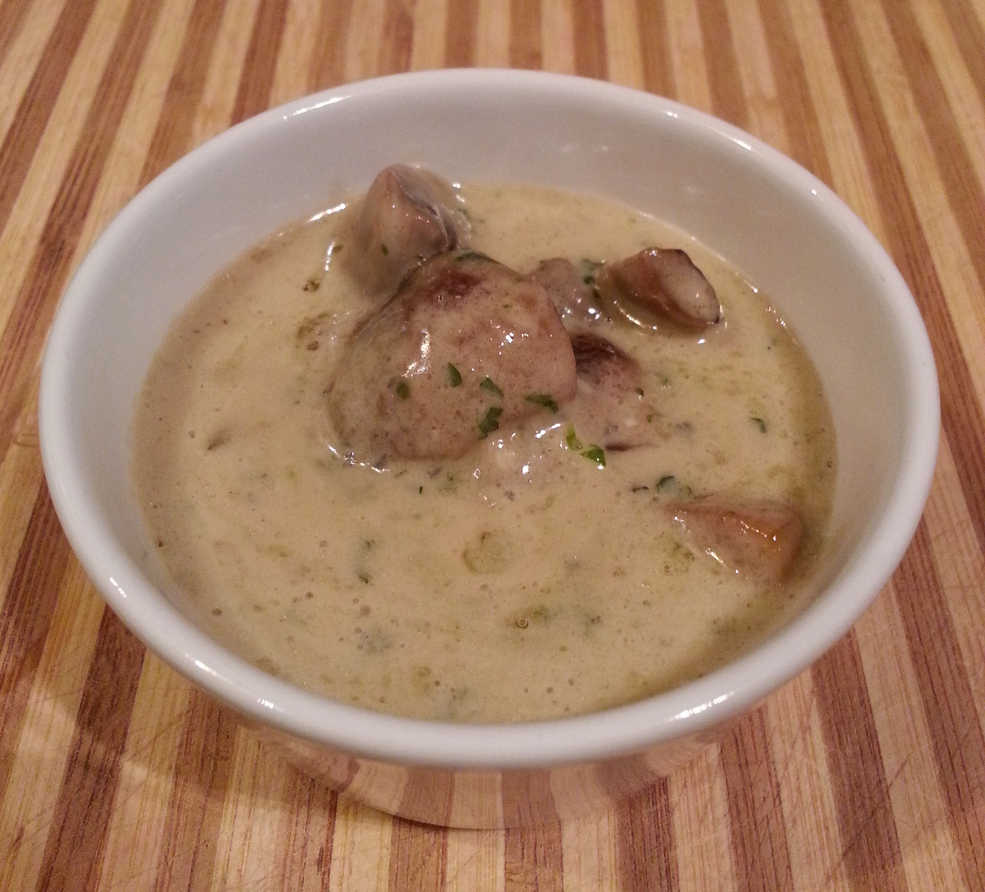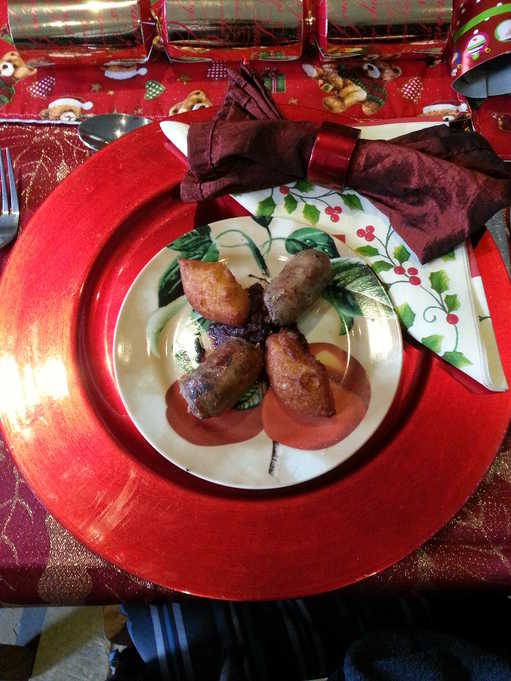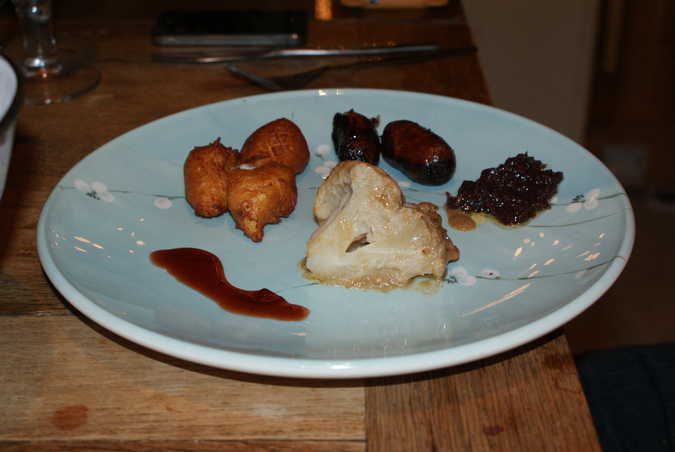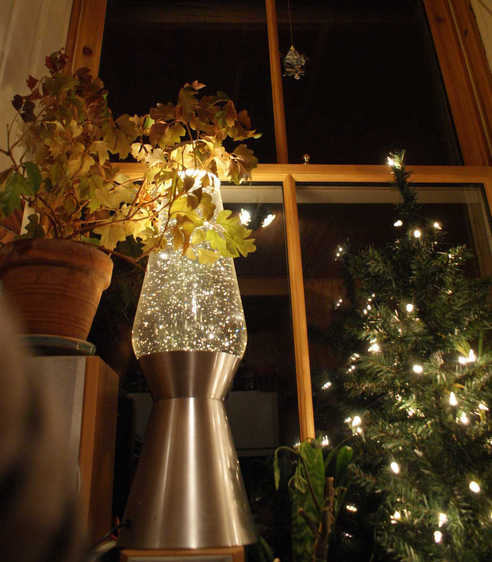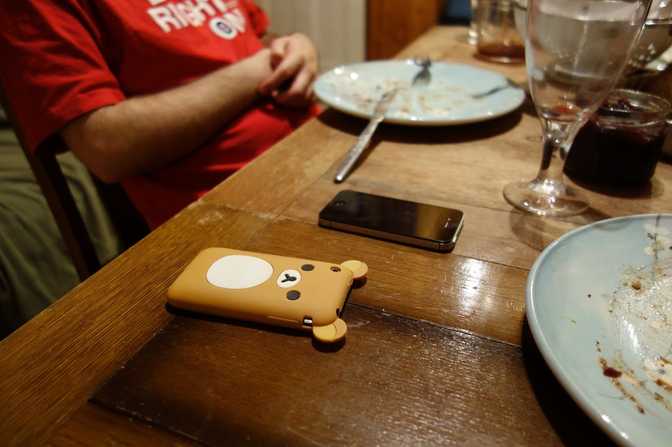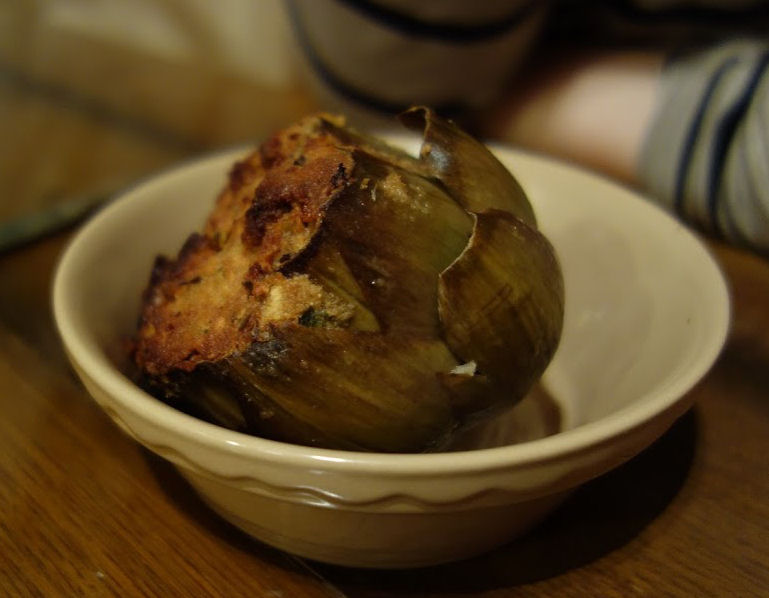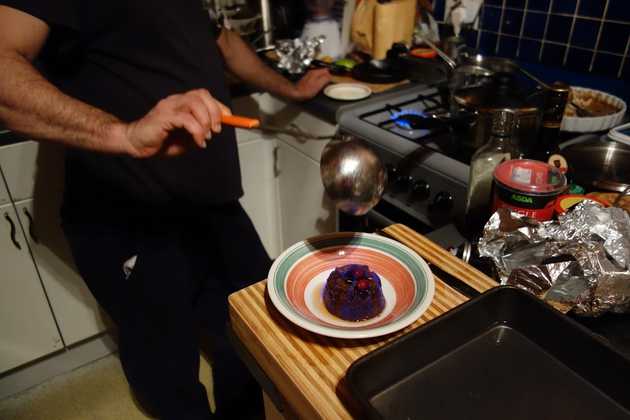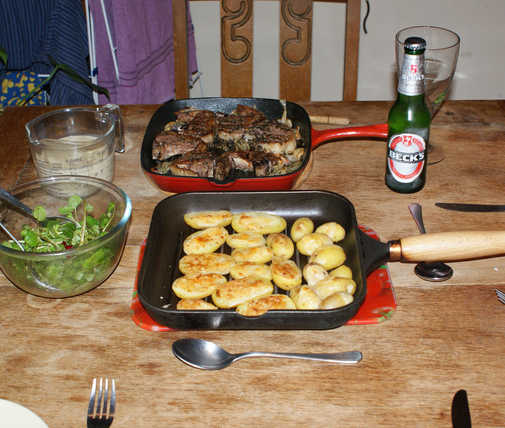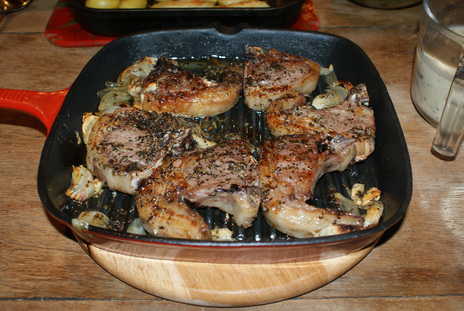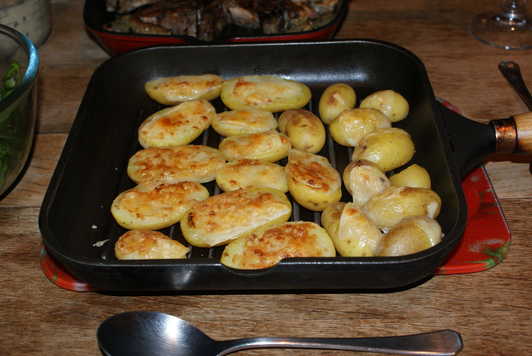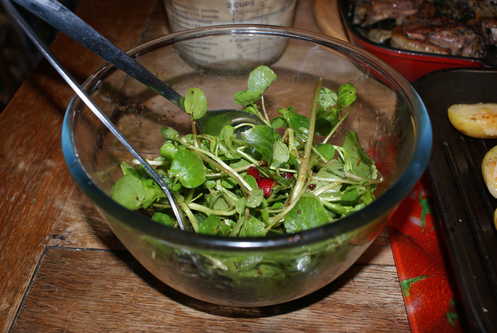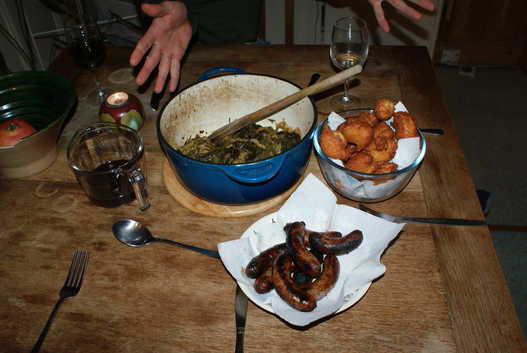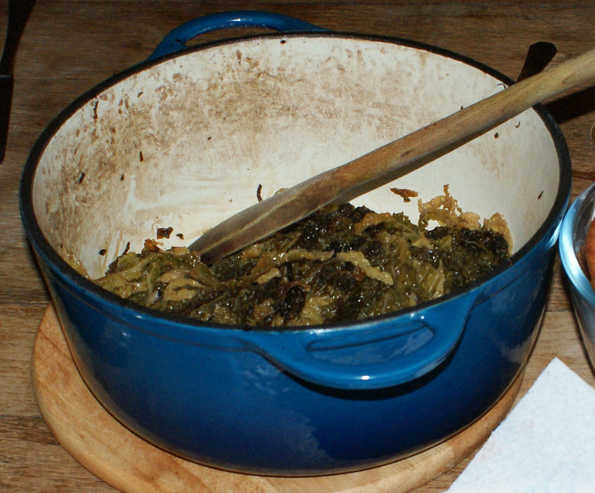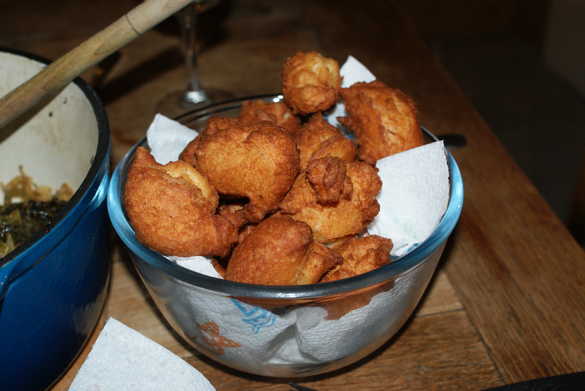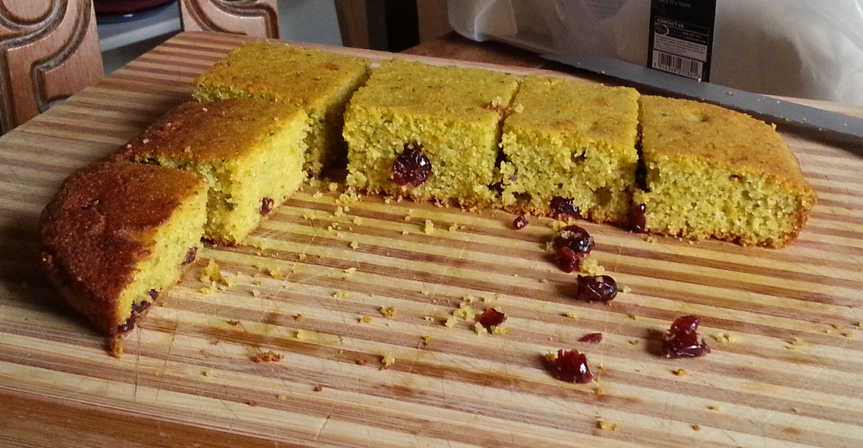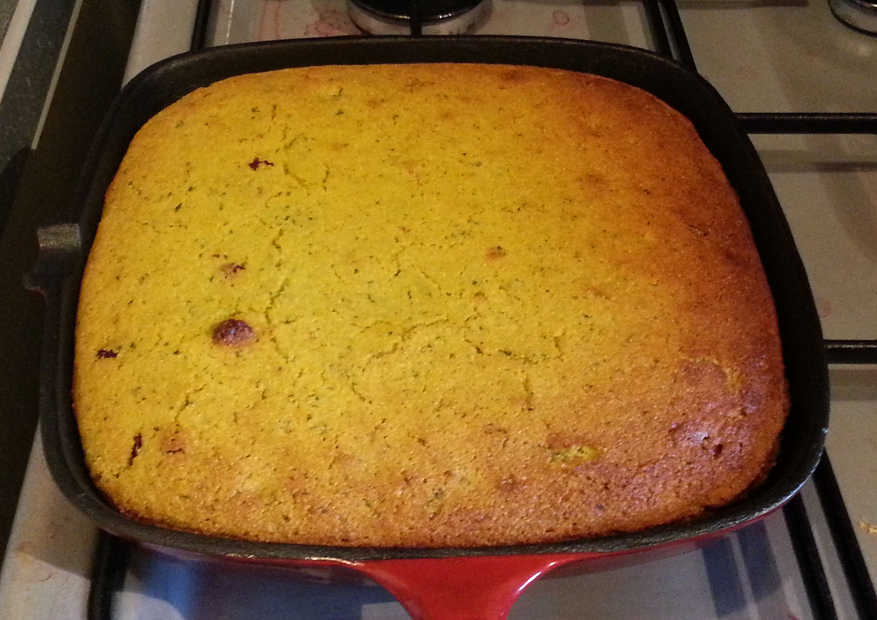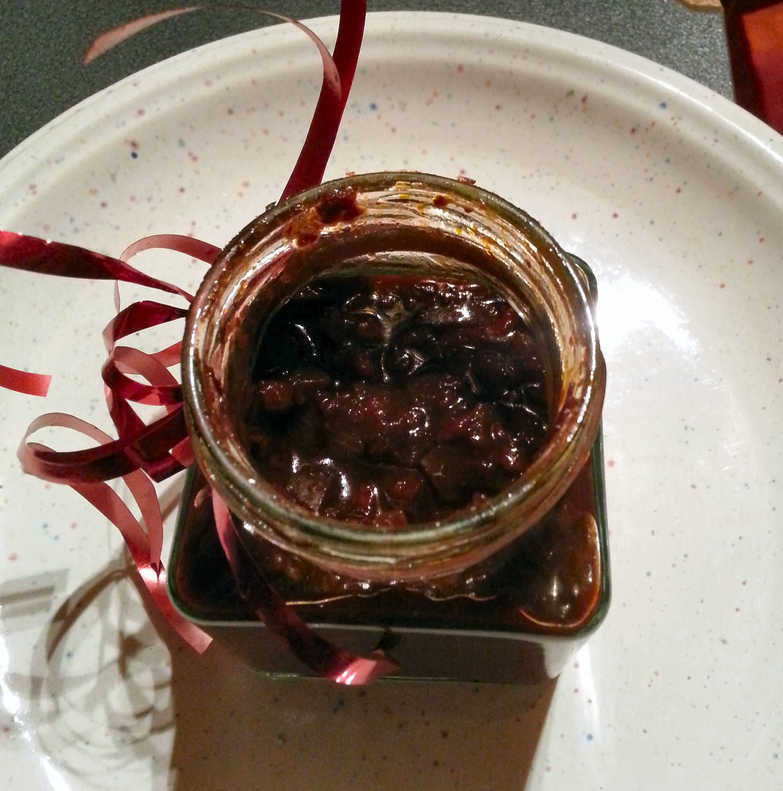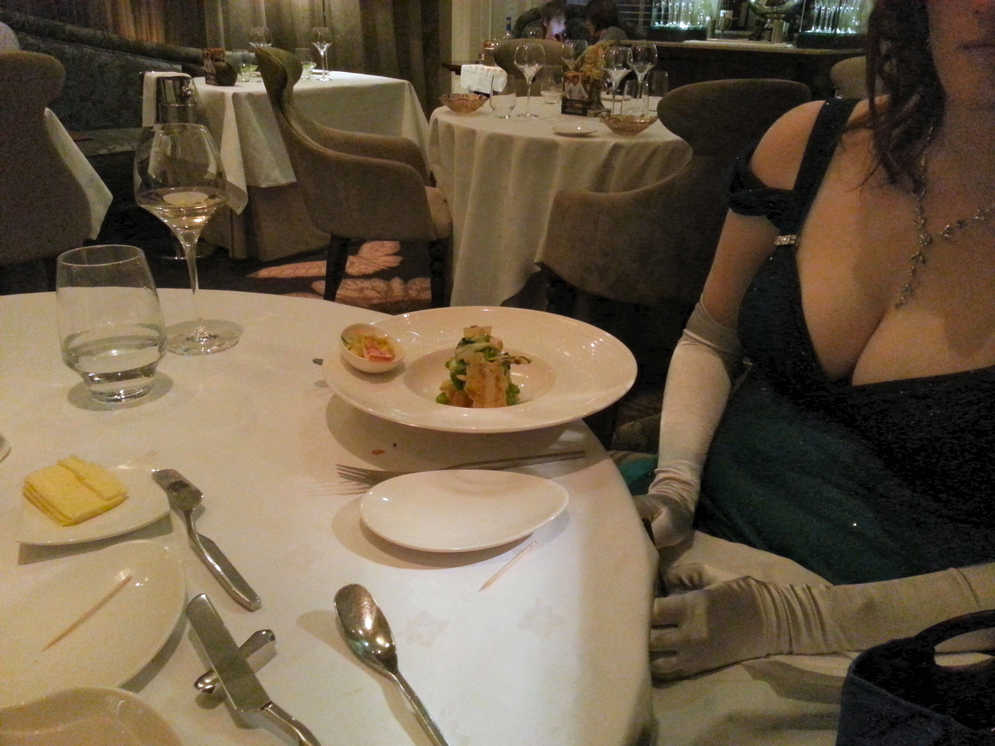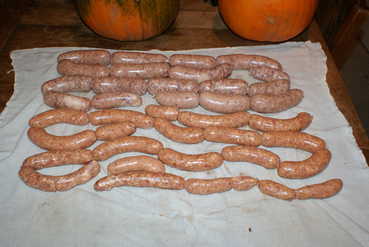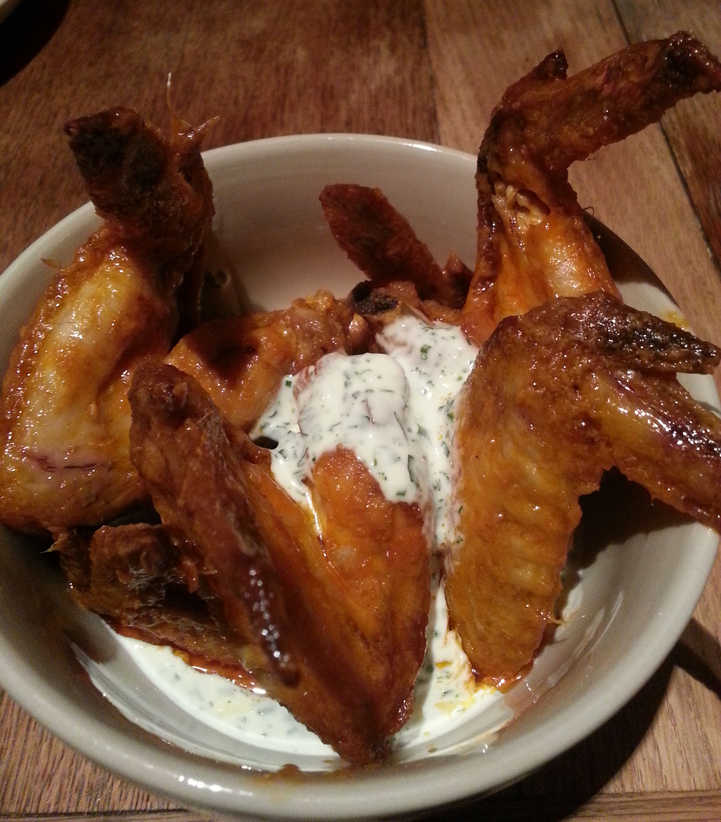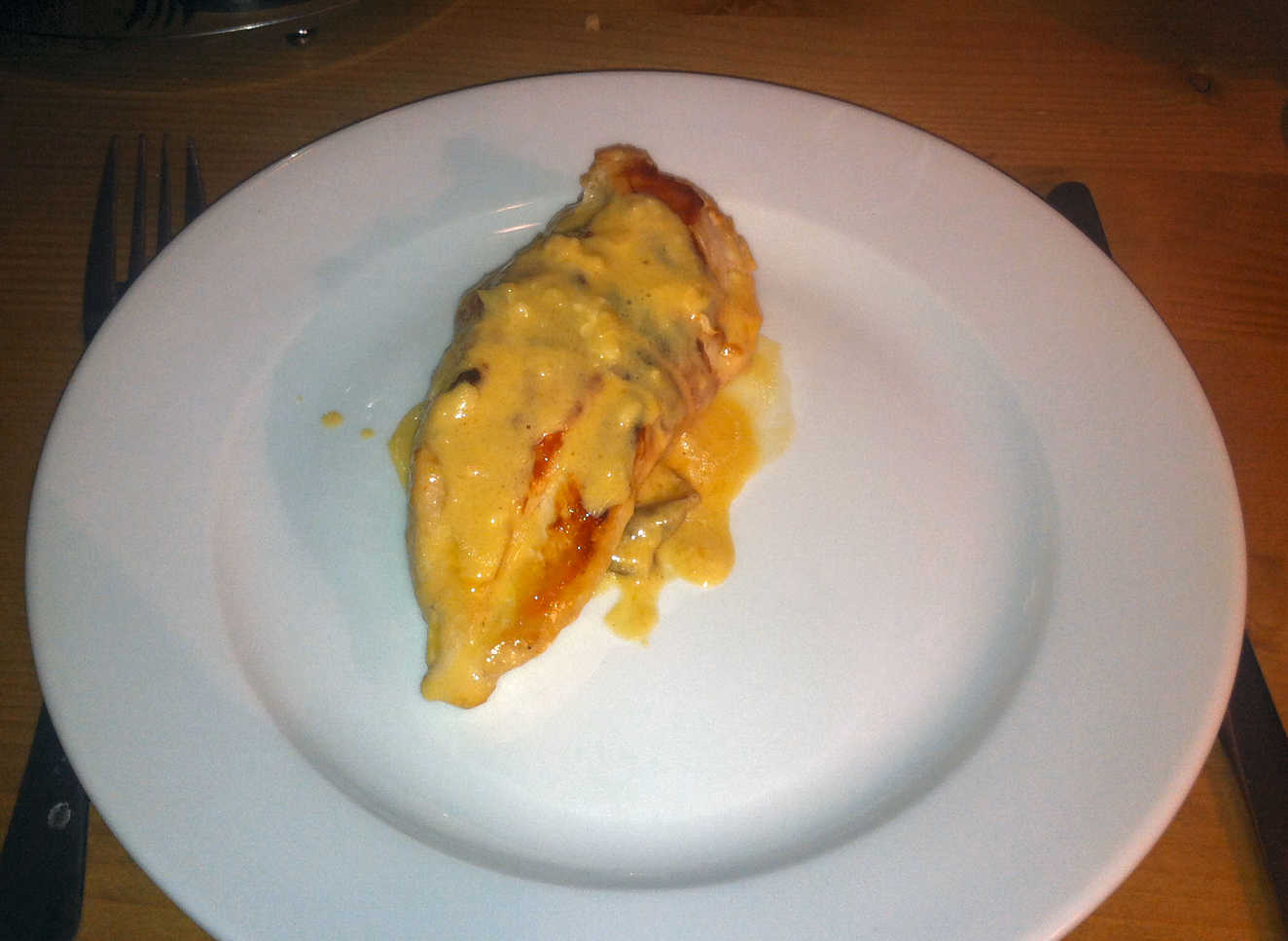
Tartiflette On Skis

I'm back from a veeeeery long ski holiday in the French Alps
(Les Carroz don'cha know) with a group of instructors from the
Firbush outdoor centre.
Naturally they're all quite experienced skiers, which made the eight full days on the slopes quite hard work for someone who hasn't skied for about 5 years, and who wasn't all that great to start with.
Despite winning the medal for the fallingest skier, I survived the trip even if it did take over a week for my legs to recover.
Possibly from that wipeout when my kneecap did its best to pop itself off my leg.
We took a self-catering apartment - so naturally we ate well, taking turns to cook dinner for everyone. I turned out a depressingly unauthentic moussaka-lika (honestly, the pun is better than the dish), but a very tasty and well-received pan-fried chicken breasts wrapped in bacon (as opposed to that other kind fried on a dustbin lid), glazed carrots with orange and honey, served with boiled potatoes.
We allowed our budget one night out on the town and I sampled the local speciality Tartiflette for dinner at a very homely restaurant Le Neve in the village square.
I also enjoyed their version of Crème Brûlée, which they flamed off at the table with a shot of the local wormwood-based hooch génépi (vaguely related to Chartreuse).
On the return flight I filled out my baggage allowance with local meat and cheeses including, naturally, a couple of Reblochons so I could have a go at my own tartiflette.
I have to say it was every bit as good as theirs.
Naturally they're all quite experienced skiers, which made the eight full days on the slopes quite hard work for someone who hasn't skied for about 5 years, and who wasn't all that great to start with.
Despite winning the medal for the fallingest skier, I survived the trip even if it did take over a week for my legs to recover.
Possibly from that wipeout when my kneecap did its best to pop itself off my leg.
We took a self-catering apartment - so naturally we ate well, taking turns to cook dinner for everyone. I turned out a depressingly unauthentic moussaka-lika (honestly, the pun is better than the dish), but a very tasty and well-received pan-fried chicken breasts wrapped in bacon (as opposed to that other kind fried on a dustbin lid), glazed carrots with orange and honey, served with boiled potatoes.
We allowed our budget one night out on the town and I sampled the local speciality Tartiflette for dinner at a very homely restaurant Le Neve in the village square.
I also enjoyed their version of Crème Brûlée, which they flamed off at the table with a shot of the local wormwood-based hooch génépi (vaguely related to Chartreuse).
On the return flight I filled out my baggage allowance with local meat and cheeses including, naturally, a couple of Reblochons so I could have a go at my own tartiflette.
I have to say it was every bit as good as theirs.
Tartiflette
main cheese
A cheesy bacon and potato gratin.
Skiing in the alpine Savoie region of France I just had to try their (not-so-very-ancient)
tartiflette.
Then I just had to make their tartiflette.
Despite giving the impression of being a traditional local speciality, it was actually developed as a marketing promotion in 1980 by the Reblochon cheesemakers. Though it doesn't taste any worse for that.
So who better to tell you how to make a tartiflette than that cynosure of everything homely, earthy and above all French, Anthony Bourdain.
Astonishingly he does not include garlic in his recipe (I did), and I can't help feeling that he is overly optimistic about the number of people the dish might feed - he reckons on 6, I would count myself lucky to feed 4. But then perhaps his guests are more blasé about this fine dish, whereas I had to go to France to get my Reblochon.
I used a dry-cured smoked saucisson sec instead of the bacon (well, I had just been to France for the Reblochon), which worked just fine (you don't need to fry it up as much). Also I diced the potatoes - the better to distinguish the dish from a gratin I thought (though the tartiflette I had in France just sliced them). Opinions vary as to the best gratin potato but I would suggest a fairly waxy variety like Desiree, Estima or Maris Peer that will hold its shape against the tide of cheese. I used Charlotte potatoes, didn't bother to peel them and I boiled 'em up pretty good there too: in fact they were breaking up so much that they might as well have been diced!
It is quite stodgy though, so feel free to add a couple of tablespoons of crème fraîche which loosens it up nicely. Don't overdo it though - it will get sloppy quite quickly.
Smoked salmon makes an effective substitute for the meat-averse. Just chop it into lardon-sized pieces and add it to the onions when you mix in the potatoes - no need to fry it. It's a stronger flavour than the bacon though - so you might want to use less than 200g of it. I added sour cream and a little chopped dill when I made mine, which was quite delicious, though I think the dill was probably unnecessary.
Then I just had to make their tartiflette.
Despite giving the impression of being a traditional local speciality, it was actually developed as a marketing promotion in 1980 by the Reblochon cheesemakers. Though it doesn't taste any worse for that.
So who better to tell you how to make a tartiflette than that cynosure of everything homely, earthy and above all French, Anthony Bourdain.
Astonishingly he does not include garlic in his recipe (I did), and I can't help feeling that he is overly optimistic about the number of people the dish might feed - he reckons on 6, I would count myself lucky to feed 4. But then perhaps his guests are more blasé about this fine dish, whereas I had to go to France to get my Reblochon.
I used a dry-cured smoked saucisson sec instead of the bacon (well, I had just been to France for the Reblochon), which worked just fine (you don't need to fry it up as much). Also I diced the potatoes - the better to distinguish the dish from a gratin I thought (though the tartiflette I had in France just sliced them). Opinions vary as to the best gratin potato but I would suggest a fairly waxy variety like Desiree, Estima or Maris Peer that will hold its shape against the tide of cheese. I used Charlotte potatoes, didn't bother to peel them and I boiled 'em up pretty good there too: in fact they were breaking up so much that they might as well have been diced!
It is quite stodgy though, so feel free to add a couple of tablespoons of crème fraîche which loosens it up nicely. Don't overdo it though - it will get sloppy quite quickly.
Smoked salmon makes an effective substitute for the meat-averse. Just chop it into lardon-sized pieces and add it to the onions when you mix in the potatoes - no need to fry it. It's a stronger flavour than the bacon though - so you might want to use less than 200g of it. I added sour cream and a little chopped dill when I made mine, which was quite delicious, though I think the dill was probably unnecessary.
Serves 4
Ingredients
- 2½lb/1.1 kg potatoes, peeled or not, your choice
- 2 tbsps oil
- 1-2 medium onions, halved, thinly sliced or diced
- ½lb/225g ventrèche, smoked bacon or smoked sausage cut into lardons or 200g smoked salmon
- 3 cloves garlic, thinly sliced
- ¾ cup/200ml white wine
- a tablespoon or two of cream or crème fraîche optional and to taste
- salt and pepper
- 1lb/450g Reblochon cheese
Preheat the oven to 350°F/175°C/Gas 4.
Place the potatoes in a large pot, cover and bring to the boil. Cook for about 20 minutes, or until the potatoes are easily pierced with a paring knife. Remove from the heat, drain and sit until they are cool enough to handle. Cut the potatoes into ¼" slices or small dice and set aside.
In a large sauté pan, heat the oil over high heat and add the onion. Cook over high heat, stirring frequently, for about 5 minutes, until golden brown, then add the bacon and cook for another 5 minutes, stirring occasionally.
Remove the mixture from the heat and place half of it in a round, ovenproof dish. Does it have to be round? Well it does fit the shape of the cheese. Cut the Reblochon in half horizontally across its middle. Spread one half of the Reblochon over the potato mix in the dish. I suppose you could scrape the cheese off the skin to do this, but I just chopped up the half cheese skin and all and scattered it over. Seemed to work fine! Cover this with the other half of the potato mixture. Lay on top the other half of the cheese, skin-side up. Bake in the oven for 20 minutes, or until golden brown and bubbling.
Serve hot with a green salad, pickles, crusty bread and the rest of that white wine.
Place the potatoes in a large pot, cover and bring to the boil. Cook for about 20 minutes, or until the potatoes are easily pierced with a paring knife. Remove from the heat, drain and sit until they are cool enough to handle. Cut the potatoes into ¼" slices or small dice and set aside.
You can peel them too if they're big, ugly and thick-skinned like a Tory MP.
Cut the bacon into lardons or small dice.In a large sauté pan, heat the oil over high heat and add the onion. Cook over high heat, stirring frequently, for about 5 minutes, until golden brown, then add the bacon and cook for another 5 minutes, stirring occasionally.
If you prefer a whiter shade of pale, then fry the bacon first, then add the onion and fry until it softens.
Maybe with a hint of browning.
Add the garlic and stir through.
De-glaze with the wine and bubble to reduce.
And some cream if you fancy.
Don't add too much or the dish will be sloppy.
Add the potatoes and season with salt and pepper.
Mix thoroughly over medium heat for a few minutes, stirring occasionally.
Remove the mixture from the heat and place half of it in a round, ovenproof dish. Does it have to be round? Well it does fit the shape of the cheese. Cut the Reblochon in half horizontally across its middle. Spread one half of the Reblochon over the potato mix in the dish. I suppose you could scrape the cheese off the skin to do this, but I just chopped up the half cheese skin and all and scattered it over. Seemed to work fine! Cover this with the other half of the potato mixture. Lay on top the other half of the cheese, skin-side up. Bake in the oven for 20 minutes, or until golden brown and bubbling.
Serve hot with a green salad, pickles, crusty bread and the rest of that white wine.
I Served mine with a salad with chopped tomatoes, gherkins, green olives and pickled onions,
but I drank all the wine myself.
I did have to turn the oven up to Gas 7/425°F/220°C to get the cheese to brown at the end. And although I didn't add any cream (or crème fraîche), I think a dash might have loosened it up nicely.
Delicious stuff though - even if it's part of no diet.
I did have to turn the oven up to Gas 7/425°F/220°C to get the cheese to brown at the end. And although I didn't add any cream (or crème fraîche), I think a dash might have loosened it up nicely.
Delicious stuff though - even if it's part of no diet.
I've also made this dish using up leftover Christmas smoked salmon pâté
and Chaource and Vacherin Mont d'Or cheeses
Thanks Flora! which was also excellent.
So don't feel you need to restrict yourself to Reblechon.
It's Moussaka Jim, but not as we know it.
Moussaka Lika
main meat
A traditional moussaka would usually be made with minced veal or possibly lamb,
flavoured with cinnamon and nutmeg,
layered into a dish with fried aubergine slices,
topped with béchamel sauce and then baked.
On a skiing holiday in the alps with no oven, I made a vague attempt at a moussaka-lika on the stove top using some of our spare vin chaud flavoured with cinnamon, cloves and oranges.
I also threw in some decidedly un-traditional kidney beans, red peppers, mushrooms and crumbled oatcakes (thanks Mark!).
Hey, you work with what you've got.
On a skiing holiday in the alps with no oven, I made a vague attempt at a moussaka-lika on the stove top using some of our spare vin chaud flavoured with cinnamon, cloves and oranges.
I also threw in some decidedly un-traditional kidney beans, red peppers, mushrooms and crumbled oatcakes (thanks Mark!).
Hey, you work with what you've got.
Feeds 6
Ingredients
- large (800g) can red kidney beans
- 3 aubergines, chopped into 1" cubes
- olive oil
- 500g mince
- packet oatcakes, crumbled optional!
- 2-4 tablespoons tomato purée
- 4-6 onions, chopped
- ½ head garlic, peeled, sliced
- 2 red peppers, chopped
- 250-500g button mushrooms, quartered
- vin chaud or red wine, cinnamon, cloves and orange juice
Empty the kidney beans into a large pot and keep it gently simmering.
Chop the aubergines, heat up a generous layer of olive oil in a deep frying pan and fry the aubergine until it browns and the skin begins to crisp. Add to the kidney beans in the large pot.
Chop the red pepper into chunks, fry gently, then add to the pot.
Slice the garlic, fry gently and add to the pot.
Quarter the mushrooms, fry until starting to shrink then add to the pot.
Simmer the moussaka until the aubergines are no longer made of leather, and serve.
Chop the aubergines, heat up a generous layer of olive oil in a deep frying pan and fry the aubergine until it browns and the skin begins to crisp. Add to the kidney beans in the large pot.
You'll probably need a lot of oil - those aubergines are thirsty suckers.
You can salt or microwave them for a minute or two to cut down on that.
Fry the mince until it colours, crumble in the oatcakes, stir in tomato purée, fry until the oil separates then add to the pot.
You can salt or microwave them for a minute or two to cut down on that.
Deglaze the frying pan with vin chaud, or red wine, or any liquor you have spare, and add this to the pot too.
Do this every time you need to after frying up the following ingredients...
Roughly chop the onions, fry until glassy and add to the pot.Do this every time you need to after frying up the following ingredients...
Chop the red pepper into chunks, fry gently, then add to the pot.
Slice the garlic, fry gently and add to the pot.
Quarter the mushrooms, fry until starting to shrink then add to the pot.
Simmer the moussaka until the aubergines are no longer made of leather, and serve.
Probably best described as scran, and none the worse for that.
Orange Glazed Carrots
side veg
Orange-flavoured carrots is a theme I often revisit. Here's one of many versions...
Ingredients
- carrots, peeled, julienned
- knob of butter
- orange juice
- honey
- salt
Peel and julienne the carrots into thick matchsticks. Put in a heavy pot with a generous knob of butter,
a dose of salt, a coating of orange juice, and a blob of honey.
Put on a tight-fitting lid and simmer gently over a low heat until the liquid is mostly absorbed and the carrots are tender.
Put on a tight-fitting lid and simmer gently over a low heat until the liquid is mostly absorbed and the carrots are tender.
Feel free to add liqueur, ginger, garlic, marmalade, stock cubes, or whatever else takes your fancy.
Bacon-Wrapped Chicken Breasts in Mustard Cheese Sauce
main fowl meat cheese
I didn't have any flour around when I made the sauce for this dish, so I thickened it with egg yolks.
You could make a roux using flour, or finish with cornflour if you preferred.
You could make a roux using flour, or finish with cornflour if you preferred.
1 breast per person. 2 for hungry skiers.
Ingredients
- chicken breasts
- 2-3 bacon slices per breast
- garlic, thinly sliced or pressed
- white wine
- cream or milk if you're desperate
- Dijon mustard
- grated cheese gruyère, Comté, Vacherin, or whatever you like
- egg yolks
Wrap the chicken breasts in bacon. Fry them in a little oil until the chicken is cooked through and the bacon crisped.
Remove from the pan with a slotted spoon and set aside in a warmed serving dish. Pour off the excess fat and reserve to flavour the boiled potatoes.
Add the thinly sliced, or crushed, garlic and fry briefly before deglazing the pan with white wine, then add cream, mustard, and grated cheese.
Heat gently until the cheese melts, then whisk in the egg yolks without boiling until the sauce thickens. Do this by whisking the yolks in a cup, add a little of the sauce to the yolks, then add the yolks back to the rest of the sauce .
Season and pour over the chicken breasts and serve with boiled or steamed new potatoes dressed with the reserved fat.
Remove from the pan with a slotted spoon and set aside in a warmed serving dish. Pour off the excess fat and reserve to flavour the boiled potatoes.
Add the thinly sliced, or crushed, garlic and fry briefly before deglazing the pan with white wine, then add cream, mustard, and grated cheese.
Heat gently until the cheese melts, then whisk in the egg yolks without boiling until the sauce thickens. Do this by whisking the yolks in a cup, add a little of the sauce to the yolks, then add the yolks back to the rest of the sauce .
Season and pour over the chicken breasts and serve with boiled or steamed new potatoes dressed with the reserved fat.
Delicious. Served with orange-glazed carrots it's a bit like a poor man's Nell Gwynn's Breasts.
Leftover Christmas

Christmas is over - time once again to start frantically inventing novel ways of using up the leftovers. Lots of leftovers. I say frantically because it's now been 3 weeks and counting and even the cheese is starting to get a bit suspect!
It's also a handy way of feeding Doctor Jenny, who's moved in with me while she operates on sick children.
Well, someone has to do it now that rapey Uncle Jimmy is no longer available.
Although she's complained bitterly about the lack of dinner choice she gets from being cooked for and waited on hand and foot, I have noticed that on her days off all she eats are my leftover leftovers, so I must be doing something right.
To be fair she also complains bitterly about the absurd length of time it takes me to get her dinner on the table. As we should know full well by now - girls need feeding instantly.
Must cook faster, must cook faster.
I had to use up the leftover goose first since it started getting a bit whiffy, which I did by just wrapping it up in tin foil with a handful of dried cranberries, a few par-cooked potatoes, quartered onions and choice herbs then roasting it in a low oven.
Then I ate it with some pickles right out of the foil like a tramp.
Yum.
Heston's Chicken and Ham Pie
main meat fowl
Or Turkey and Ham, or Goose and Ham I suppose - since we're using up Christmas leftovers.
I very much simplified Heston's ludicrous recipe by using some onion and rosemary sauce I'd made earlier, and skipping the whole chicken-brining business.
Heston obviously has the hots for agar-agar though so maybe that's worth thinking about?
Heston: A great technique for thickening sauces and pie fillings is to use a tablespoon of agar agar flakes instead of starch. Agar agar is a setting agent derived from seaweed and it ensures a really smooth finish without masking flavour as starch does. Agar agar is also a good vegetarian replacement for gelatin and it is a lot more heat resistant.
Since Jenny and her beau Alistair don't like to wait more than THIRTY SECONDS for their dinner I occupied them with decorating the pie crust. Jenny chose a tiny pac-man and mini ghost theme. Can you tell?
I very much simplified Heston's ludicrous recipe by using some onion and rosemary sauce I'd made earlier, and skipping the whole chicken-brining business.
Heston obviously has the hots for agar-agar though so maybe that's worth thinking about?
Heston: A great technique for thickening sauces and pie fillings is to use a tablespoon of agar agar flakes instead of starch. Agar agar is a setting agent derived from seaweed and it ensures a really smooth finish without masking flavour as starch does. Agar agar is also a good vegetarian replacement for gelatin and it is a lot more heat resistant.
Since Jenny and her beau Alistair don't like to wait more than THIRTY SECONDS for their dinner I occupied them with decorating the pie crust. Jenny chose a tiny pac-man and mini ghost theme. Can you tell?
A two-recipe, three-mustard dish!
Three Mustard Pork Stroganoff
main meat
Pesto Crusted Salmon
main fish cheese
When I made this I had a whole frozen side of salmon to use up (I defrosted it first!),
and it seemed like a pesto coating of some kind would make a nice change from
liquorice :)
So I did a couple of experiments, coating part of the fish in only pesto, part of it with mixed breadcrumbs, pesto and extra Parmesan, and the final third with some crushed peanuts added to the mix. (I like the idea of combining peanuts with pesto so I thought I'd give this a go.)
The breadcrumb/pesto mix was definitely the best, though the pure pesto was also acceptable. It just lacked that interesting bit of crunch and the attractive golden colour of the breadcrumbs (especially with the extra cheese), and might have worked better as a wrapped parcel, rather than open.
Mind you if you are looking for a bright green fishy wrap then the pesto is your man.
The peanuts didn't really work - they just made the topping heavy and cloying.
So I did a couple of experiments, coating part of the fish in only pesto, part of it with mixed breadcrumbs, pesto and extra Parmesan, and the final third with some crushed peanuts added to the mix. (I like the idea of combining peanuts with pesto so I thought I'd give this a go.)
The breadcrumb/pesto mix was definitely the best, though the pure pesto was also acceptable. It just lacked that interesting bit of crunch and the attractive golden colour of the breadcrumbs (especially with the extra cheese), and might have worked better as a wrapped parcel, rather than open.
Mind you if you are looking for a bright green fishy wrap then the pesto is your man.
The peanuts didn't really work - they just made the topping heavy and cloying.
A fortuitous invention
Broccoli with Olives and Lemon
side veg vegan
A quick and simple way of cooking broccoli that was surprisingly well received.
Serves 4
Ingredients
- a head of broccoli, broken into florets
- olive oil
- 1-2 cloves garlic, sliced
- juice and peel of half a lemon
- a dozen black olives, halved
- ½ teaspoon salt
Break the broccoli into florets, halving or quartering larger ones.
Pare the lemon peel into thin strips (or grate it if you can't be bothered or don't have a fancy lemon zester) and juice it (you'll need about half the juice, but perhaps all the peel).
Stone about a dozen (or fewer) black olives and cut them in halves or quarters.
Heat a generous amount of olive oil in a pan with a tight-fitting lid large enough to almost fill with the broccoli and fry the broccoli over a high heat, shaking occasionally until it has browned around the edges.
Throw in the garlic cloves, give the pan a good shake, then add the lemon juice, olives and salt and cover. Turn the heat down to its lowest setting and leave until the broccoli is tender, shaking occasionally (about 10 minutes).
Add the lemon peel and serve.
Pare the lemon peel into thin strips (or grate it if you can't be bothered or don't have a fancy lemon zester) and juice it (you'll need about half the juice, but perhaps all the peel).
Stone about a dozen (or fewer) black olives and cut them in halves or quarters.
Heat a generous amount of olive oil in a pan with a tight-fitting lid large enough to almost fill with the broccoli and fry the broccoli over a high heat, shaking occasionally until it has browned around the edges.
Throw in the garlic cloves, give the pan a good shake, then add the lemon juice, olives and salt and cover. Turn the heat down to its lowest setting and leave until the broccoli is tender, shaking occasionally (about 10 minutes).
Add the lemon peel and serve.
Really good. And really easy. Score!
Another attempt to adulterate lychees
Lychees with Basil Cream
dessert raw veg
Quite a nice combination of flavours if you're not a lychee purist (Flora!).
Ingredients
- Lychees, peeled, stoned, halved
- double cream
- basil
Peel the lychees, remove the stones and any hard brown layers and cut into halves or quarters.
It helps if you cut the stalk end off with a sharp knife first.
Blend some basil with a small amount of cream (loosening it with milk as necessary so it doesn't turn into cheese).
Gently stir this intense green paste through some more cream to create an attractive basil swirl.
Dress the lychees and serve.
Blend some basil with a small amount of cream (loosening it with milk as necessary so it doesn't turn into cheese).
Gently stir this intense green paste through some more cream to create an attractive basil swirl.
Dress the lychees and serve.
Well, I liked it ;)
Baked Apples stuffed with Mincemeat
dessert veg
A terrific way to use up that leftover mincemeat!
Mushrooms in a Blue Cheese Sauce
side sauce veg cheese
Leftover mushrooms make a fine complement to a blue cheese sauce. Made from leftover blue cheese.
Makes sauce for 2
Ingredients
- half dozen button mushrooms, quartered
- knob butter
- 1 clove garlic
- glass brandy or white wine
- small bunch parsley, washed, chopped
- ½ cup or so double cream
- 2 oz blue cheese
- 2 oz Brie
Clean the mushrooms and cut them into quarters.
Fry in a generous knob of butter over high heat until they colour and just start to lose their moisture.
Slice or press the garlic and add to the mushrooms.
Add a glass of brandy, white wine, or whatever liqueur you fancy and flame or reduce.
Add double cream and chopped parsley (preferably curly) and simmer gently to reduce a little.
Crumble in the blue cheese and slices of Brie (or just use all blue cheese if you like), stir until melted, season (probably not much) and serve.
Fry in a generous knob of butter over high heat until they colour and just start to lose their moisture.
Slice or press the garlic and add to the mushrooms.
Add a glass of brandy, white wine, or whatever liqueur you fancy and flame or reduce.
Add double cream and chopped parsley (preferably curly) and simmer gently to reduce a little.
Crumble in the blue cheese and slices of Brie (or just use all blue cheese if you like), stir until melted, season (probably not much) and serve.
Great with steak, or just as a pasta sauce.
It's Christmas!
'Tis the season.
Again.
Merry 2012 to one and all - what's left of it!
Here's everything which makes today such a special time:
Hopefully sometime in 2013 I'll find time to finish writing about my fabulous fiftieth birthday week OMG!
Again.
Merry 2012 to one and all - what's left of it!
Here's everything which makes today such a special time:
Hopefully sometime in 2013 I'll find time to finish writing about my fabulous fiftieth birthday week OMG!
Pre-Christmas Dinner
Last chance to practice my Christmas Starter. Alex and his new inamorata Caroline were kind enough to volunteer this time.
So I've zeroed in on the Zirbenz sausages
with the pommes dauphine,
and the red onion marmalade.
This time I'll be serving them with a very satisfying stuffed artichoke starter,
an excellent aromatic cauliflower,
and some quick and easy mini Christmas puddings to finish.
Yummy!
Yummy!
Stuffed Roast Artichoke
starter
Artichokes stuffed with breadcrumbs and a creamy dip, then baked.
I had the idea of re-creating a favourite hot artichoke dip but using fresh artichokes
and stuffing them with the dip mixture.
They make a great starter actually - the breadcrumbs add a nice crunchy texture whilst the mayonnaise mixture provides a pleasant tang.
You need to keep an eye on their baking and adjust the temperature so the artichokes are cooked when their tops are browned, covering them for a while if necessary.
It might also be possible to bake them all the way from raw without bothering to par-cook them first.
They make a great starter actually - the breadcrumbs add a nice crunchy texture whilst the mayonnaise mixture provides a pleasant tang.
You need to keep an eye on their baking and adjust the temperature so the artichokes are cooked when their tops are browned, covering them for a while if necessary.
It might also be possible to bake them all the way from raw without bothering to par-cook them first.
Serve one artichoke per person
Ingredients
- artichokes
- lemon
For the stuffing:- dried breadcrumbs
- mixed dried herbs
- half mayonnaise
- half sour cream
- pickled jalapeños, chopped
- garlic, crushed
- spring onions, thinly sliced
- Parmesan, grated
First you can make up an Italian-style breadcrumb mix.
Dry some crust-less bread slices in the oven or grill. Process them to fine golden crumbs in a blender.
Stir in your preferred mixture of dried herbs, any from
Stir together half mayonnaise and half sour cream, and fold in some chopped pickled jalapeños from a jar, crushed garlic, and some shredded spring onion optional. Add enough of this mixture to the breadcrumb blend to make it cohere into clumps, but not so much that it becomes sloppy.
Set aside.
Now prepare the artichokes: cut off the stalks close to the body so the bulbs will stand up. Remove the darker, thicker, lower leaves (probably just one layer). Cut the top of the artichoke off about half an inch down taking off the top layer of leaves. Halve a lemon and rub the cut parts of the heads with the lemon, or drizzle with lemon juice. With a pair of scissors snip away the tips of all the remaining leaves to remove their hooked barbs, then take a teaspoon and carefully scoop out the hairy choke from the centre of the head. Drizzle in some more lemon juice.
Preheat the oven to Gas 4-5/180°C/360°F.
Once the artichokes are cool enough to handle, stuff them thoroughly with the prepared mixture, using a dessert spoon to prise open the leaves and force stuffing into every gap.
Arrange them upright in a baking tray or oven-proof dish, pour in enough water or white wine, stock or other poaching liquid you fancy to come about half-way up and bake them until the tops are golden and their leaves pull away easily.
- oregano
- marjoram
- thyme
- basil
- onion powder
- garlic powder
- black pepper
Stir together half mayonnaise and half sour cream, and fold in some chopped pickled jalapeños from a jar, crushed garlic, and some shredded spring onion optional. Add enough of this mixture to the breadcrumb blend to make it cohere into clumps, but not so much that it becomes sloppy.
Set aside.
Now prepare the artichokes: cut off the stalks close to the body so the bulbs will stand up. Remove the darker, thicker, lower leaves (probably just one layer). Cut the top of the artichoke off about half an inch down taking off the top layer of leaves. Halve a lemon and rub the cut parts of the heads with the lemon, or drizzle with lemon juice. With a pair of scissors snip away the tips of all the remaining leaves to remove their hooked barbs, then take a teaspoon and carefully scoop out the hairy choke from the centre of the head. Drizzle in some more lemon juice.
You can do this when the artichokes are cooked if you prefer,
or even not at all if your guests don't mind picking the hairy clumps out of their mouths.
Put the artichokes upright in a steamer or a tightly-closed pan with enough water squeeze in some lemon juice too
and steam them for about 5 minutes to par-cook.
They should have softened enough for a knife to penetrate their bottom, but not so much that they are fully cooked and falling apart.Preheat the oven to Gas 4-5/180°C/360°F.
Once the artichokes are cool enough to handle, stuff them thoroughly with the prepared mixture, using a dessert spoon to prise open the leaves and force stuffing into every gap.
Arrange them upright in a baking tray or oven-proof dish, pour in enough water or white wine, stock or other poaching liquid you fancy to come about half-way up and bake them until the tops are golden and their leaves pull away easily.
Very nice!
I did try just stuffing an artichoke with the wet mixture (no breadcrumbs) and baking it wrapped in foil - to be more like the inspirational dip, but the above method is better.
I did try just stuffing an artichoke with the wet mixture (no breadcrumbs) and baking it wrapped in foil - to be more like the inspirational dip, but the above method is better.
Mini Christmas Puddings
dessert veg
Serve with a rum sauce, crème fraîche or brandy butter.
Or a creamy custard as I did.
Or a creamy custard as I did.
Serves 4
Ingredients
- 2½ oz (60 g) self-raising flour
- ½ teaspoon baking powder
- ½ rounded teaspoon ground mixed spice
- 1 medium egg
- 1 oz (25 g) butter, softened
- 1½ fl oz (40 ml) black treacle
- 2 fl oz (55 ml) Irish stout or porter ;)
- 1 tablespoon dark rum
- 1½ oz (40 g) Bramley cooking apple, peeled, cored and finely diced
- ½ oz (10 g) chopped roasted hazelnuts
- 3 oz (75 g) currants soaked in your choice of liqueur (mine was Amaretto) for a day
- ½ x 400 g jar mincemeat
- grated zest ½ orange
- grated zest ½ lemon
- 12 fresh cranberries, to serve
- 1 tablespoon brandy, if flaming the puddings
Pre-heat the oven to gas mark 4, 350°F (180°C).
First sift the flour, baking powder and mixed spice into a medium bowl, then add the egg and softened butter. After that, measure the treacle into a glass measuring jug, add the stout and rum and mix these together.
Next, pour this mixture into the bowl and, using an electric hand whisk, whisk everything very thoroughly together. Now add the apple, nuts, currants, mincemeat and, finally, the grated orange and lemon zests. Then mix everything together very thoroughly, and divide the mixture among 4 well-buttered 6 fl oz (175ml) pudding basins. Top each with a small circle of buttered baking parchment, followed by a 7 inch (18 cm) square of foil large enough to fold under the edges of the basins, making a pleat all the way round to seal.
Now place the basins in the tin and place the tin in the oven. Next pour in 1 inch (2.5 cm) of boiling water from the kettle and leave to cook for 45-50 minutes, or until the puddings are springy and firm to the touch in the centre. Then remove them from the oven and let them stand for 10 minutes before carefully running a small knife around each one to turn them out on to warm serving plates.
Garnish each pudding with 3 cranberries on top. If you want to flame the puddings as they go on the table, warm a ladleful of brandy over direct heat and as soon as the brandy is hot, ask someone to set light to it using a long match. Or light it from the gas flame like a normal person and not a craven, health-and-safety obsessed freak. Place the ladle, now gently flaming, on top of the pudding — but don't pour the brandy over until you reach the table. When you do, pour it slowly over the pudding, sides and all, and watch it flame to the cheers of the assembled company!
Note: If freezing the cooked and cooled puddings, defrost thoroughly, then place in a loose parcel of foil with a couple of tablespoons of brandy sprinkled over. Re-heat on a baking tray in an oven pre-heated to gas mark 4, 350°F (180°C) for 25 minutes.
First sift the flour, baking powder and mixed spice into a medium bowl, then add the egg and softened butter. After that, measure the treacle into a glass measuring jug, add the stout and rum and mix these together.
Next, pour this mixture into the bowl and, using an electric hand whisk, whisk everything very thoroughly together. Now add the apple, nuts, currants, mincemeat and, finally, the grated orange and lemon zests. Then mix everything together very thoroughly, and divide the mixture among 4 well-buttered 6 fl oz (175ml) pudding basins. Top each with a small circle of buttered baking parchment, followed by a 7 inch (18 cm) square of foil large enough to fold under the edges of the basins, making a pleat all the way round to seal.
Now place the basins in the tin and place the tin in the oven. Next pour in 1 inch (2.5 cm) of boiling water from the kettle and leave to cook for 45-50 minutes, or until the puddings are springy and firm to the touch in the centre. Then remove them from the oven and let them stand for 10 minutes before carefully running a small knife around each one to turn them out on to warm serving plates.
Garnish each pudding with 3 cranberries on top. If you want to flame the puddings as they go on the table, warm a ladleful of brandy over direct heat and as soon as the brandy is hot, ask someone to set light to it using a long match. Or light it from the gas flame like a normal person and not a craven, health-and-safety obsessed freak. Place the ladle, now gently flaming, on top of the pudding — but don't pour the brandy over until you reach the table. When you do, pour it slowly over the pudding, sides and all, and watch it flame to the cheers of the assembled company!
Note: If freezing the cooked and cooled puddings, defrost thoroughly, then place in a loose parcel of foil with a couple of tablespoons of brandy sprinkled over. Re-heat on a baking tray in an oven pre-heated to gas mark 4, 350°F (180°C) for 25 minutes.
Excellent, almost as good as the real thing and about 2 months quicker!
A Frozen Dinner

I kind of wondered if lamb chops would cook alright straight from frozen.
It turns out the answer is yes - a nice slow roasting works pretty well, though they need a bit of crisping up under the grill to finish, and the skin was still a tiny bit leathery.
I served them with a (unnecessary, as it turns out) onion and rosemary sauce and I also made a stab at some lovely filled potato gratins though you'll need a couple of griddle pans to prepare both dishes as served up during my birthday treat dinner at Andrew Fairlie's (thanks Doctor Jenny!). His were better!
Not that my dinner guest would have noticed - turning up late and chomping through the food like a starving navvy: You know who you are.
Really - I don't know why I bother sometimes.
A quick dinner attempt
Oven-Roast Frozen Lamb Chops
main meat
So it turns out you can make a reasonable fist of cooking lamb chops from frozen - even if they end up a tiny bit leathery.
A good dose of herbs and spices help to cover that up though :)
Serves 3-4
Ingredients
- half a dozen frozen lamb chops
- 1-2 teaspoons dried mint
- ½ teaspoon dried oregano or thyme
- ½ teaspoon salt or celery salt
- 1 tsp whole grain mustard if you like
- 4-6 tablespoons olive oil
Preheat the oven to Gas 2-3/150-160°C/300-325°F.
Peel the shallots and cut into eighths lengthways.
Peel and slightly crush the garlic cloves with the side of a knife.
Pour a generous amount of olive oil into a heavy griddle. Add the shallots, garlic, herbs, mustard and salt and set on the heat until the oil begins to sizzle. Take the frozen chops from the freezer, rub them around to thoroughly coat them in the pan contents on both sides, crushing up the garlic a little. Put the pan in the oven until the chops are cooked through (50°C/120°F in the centre - about half an hour), then crisp them up under a hot grill before serving.
Peel the shallots and cut into eighths lengthways.
Peel and slightly crush the garlic cloves with the side of a knife.
Pour a generous amount of olive oil into a heavy griddle. Add the shallots, garlic, herbs, mustard and salt and set on the heat until the oil begins to sizzle. Take the frozen chops from the freezer, rub them around to thoroughly coat them in the pan contents on both sides, crushing up the garlic a little. Put the pan in the oven until the chops are cooked through (50°C/120°F in the centre - about half an hour), then crisp them up under a hot grill before serving.
Delicious, you need to be sure the chops are cooked through though - use a meat thermometer.
If you take them out when the centres are rare (50°C) they should reach medium (60°C) by the time you serve them up.
You can use the delicious pan juices in the gravy.
You can use the delicious pan juices in the gravy.
I set my oven to Gas 3, but it was perhaps cooking a little quickly.
The skin turned a little bit leathery - though that might just be a generic problem with the method.
I don't know if it would be possible to crisp the skin of the frozen chops at the start. Probably not.
At least, not without drying out the whole chop.
Individual Truffled Potato Gratins
side veg cheese
As served at Andrew Fairlie's restaurant at Gleneagles.
Though not as good.
I went with Gruyère cheese, but I don't think the flavour was quite right, a bit too pungent.
I mixed in some sour cream, since that's what I had - it was quite nice though.
I went with Gruyère cheese, but I don't think the flavour was quite right, a bit too pungent.
I mixed in some sour cream, since that's what I had - it was quite nice though.
Serve 2-4 potatoes per person
Ingredients
- a medium floury baking potato
- salad potatoes like Charlottes
- truffle oil or other flavoured butter/oil if you ran out
- cream or sour cream
- salt and pepper
- cheese in thin slices
Steam or bake the floury potato for mash, pass through a ricer, then mix with truffle oil, a dab of cream and season.
Clean the salad potatoes and steam them until tender. Plunge into water to cool them off, then cut in half and scoop out the centres. It works best if you scoop out quite a lot, leaving a fairly thin shell. No need to peel them.
Season with salt and pepper.
Fill the potato hollows back up with the mashed potato mix and level off. Lay in a single layer on a griddle and cover each potato half with a slice of cheese.
Put under a hot grill until the cheese bubbles and turns golden.
Serve immediately.
Clean the salad potatoes and steam them until tender. Plunge into water to cool them off, then cut in half and scoop out the centres. It works best if you scoop out quite a lot, leaving a fairly thin shell. No need to peel them.
Season with salt and pepper.
Fill the potato hollows back up with the mashed potato mix and level off. Lay in a single layer on a griddle and cover each potato half with a slice of cheese.
Put under a hot grill until the cheese bubbles and turns golden.
Serve immediately.
Quite nice but nowhere near Andrew Fairlie's standards.
Firstly my truffle oil turned out to be old and exhausted and no longer tasting of truffle, so I added in some hazelnut oil.
Secondly the Gruyère was a bit pungent for the job really - I liked the nuttiness, but would probably tone it down a bit - maybe Emmenthaler or a Gouda?
Finally, the cheese didn't really stick to the potato, maybe another cheese would work better, or I could try a sprinkle of potato flour or something underneath?
Firstly my truffle oil turned out to be old and exhausted and no longer tasting of truffle, so I added in some hazelnut oil.
Secondly the Gruyère was a bit pungent for the job really - I liked the nuttiness, but would probably tone it down a bit - maybe Emmenthaler or a Gouda?
Finally, the cheese didn't really stick to the potato, maybe another cheese would work better, or I could try a sprinkle of potato flour or something underneath?
Watercress and Cranberry Salad
salad raw veg vegan
A nice-looking salad, the flavours aren't too bad either. Considering that's what I had in the fridge.
Ingredients
- watercress
- cranberries, cut into quarters
Dressing:- balsamic vinegar
- grain mustard
- olive oil
- salt & pepper
Mix up the dressing ingredients.
Use quite a lot of vinegar and about twice the volume of oil.
Chop up a few cranberries into quarters don't overdo them - they're fairly tart!, toss with the watercress and the dressing.
Chop up a few cranberries into quarters don't overdo them - they're fairly tart!, toss with the watercress and the dressing.
Surprisingly good with greasy chops.
Christmas Sausage Tryouts

Time to try out my Christmas Sausage versions on a couple of unsuspecting guests.
Thanks Andy: long-suffering occasional flatmate, and Flora: longer-suffering butt of my blog!
It's a Sourville family tradition that I make the starter and the stuffing, Mum makes the main course and Kurt complains about the amount of washing up.
This year we've decided my starter will be homemade sausages with red onion marmalade (and not sure what else but I thought I'd try out some pommes dauphines), so today I'm auditioning a couple of different Christmassy flavours.
I'm going with ducky sausages seeing as it's quite seasonal and it isn't goose:
Sage and Onion: Solid, traditional flavour. Bit obvious though, plus I'm not a great fan of sage.
Cranberry and Zirbenz: Interesting. The cranberry adds a pleasant sweetness and a festive appearance, but the Zirbenz disappears without trace. Still, it's the principle of the thing!
Since I don't get home till 6 and Flora needs feeding at 7:30 I have a pretty tight dinner plan.
Fortunately I had some soup I made earlier from ham stock, leftover dried beans (cannellini and chick peas), leftover celery and a collection of leftover herbs. I call it leftover soup. Serve with extra freshly chopped herbs, lemon juice and a drizzle of olive oil.
- 18:00 Arrive home. Set the oven to gas 6
- Put in the well-pricked potatoes
- Put the white wine in to chill important!
- Prepare the butter braised cabbage and put in the bottom of the oven
- Make the port and redcurrant sauce, leave gently simmering
- Make up the pâte-à-choux
- 19:15 Mash the potatoes add to the pâte-à-choux
- Put the leftover soup on to reheat
- Put on the chip pan
- Start the sausages frying
- 19:30 Serve the soup
- Fry the pommes dauphine
- 19:45 Serve the main course
Sigh.
Butter Braised Green Cabbage
side veg
Savoy cabbage braised with butter, sage and juniper
I wanted to make a cabbage dish as rich and delicious as
buttered leeks.
I think I succeeded.
I suppose you could stir some cream through at the end if you wanted to, but it really isn't necessary. You could also throw in onions or garlic, but why mess with perfection?
I think I succeeded.
I suppose you could stir some cream through at the end if you wanted to, but it really isn't necessary. You could also throw in onions or garlic, but why mess with perfection?
Serves 4
Ingredients
- a Savoy cabbage, sliced about 2cm
- large hunk of butter, about 4 oz
- about a tablespoon of finely sliced sage leaves
- 10 juniper berries, lightly crushed
- 2 cups white wine
- 2 cups stock
- 1 teaspoon salt
Set the oven on low.
Cut away the stalk from the centre of thicker cabbage leaves, wash them thoroughly, then slice them crosswise into about 2cm strips.
Slice sage leaves finely crosswise until you have a generous tablespoon (or two if you like sage).
Lightly crush 10 juniper berries with the flat of a knife.
Heat a cast iron casserole and melt a generous hunk of butter until it foams, and covers the bottom of the pot to at least ½ an inch.
Throw in the juniper berries, swirl, then the sage leaves immediately followed by a handful of the cabbage. Stir the cabbage with a wooden spoon and add more handfuls when the pot is hot enough until it is all added and the cabbage is well coated.
Add a large glass or two of white wine and reduce it to a coating, stirring all the while.
Add the stock if you have any and reduce to a thick coating, stirring all the while.
Stir through a teaspoon of salt, put the lid on and leave in a low oven (or the bottom of a hotter one) for about an hour, until the cabbage is well cooked and meltingly tender.
Cut away the stalk from the centre of thicker cabbage leaves, wash them thoroughly, then slice them crosswise into about 2cm strips.
Slice sage leaves finely crosswise until you have a generous tablespoon (or two if you like sage).
Lightly crush 10 juniper berries with the flat of a knife.
Heat a cast iron casserole and melt a generous hunk of butter until it foams, and covers the bottom of the pot to at least ½ an inch.
Throw in the juniper berries, swirl, then the sage leaves immediately followed by a handful of the cabbage. Stir the cabbage with a wooden spoon and add more handfuls when the pot is hot enough until it is all added and the cabbage is well coated.
Add a large glass or two of white wine and reduce it to a coating, stirring all the while.
Add the stock if you have any and reduce to a thick coating, stirring all the while.
Stir through a teaspoon of salt, put the lid on and leave in a low oven (or the bottom of a hotter one) for about an hour, until the cabbage is well cooked and meltingly tender.
OMG gorgeous!
I'm sure you could use any sturdy herb or spice yep - 1-2 teaspoons each of crushed allspice, red and green peppercorns is good. Caraway might be nice. Even lemon peel/juice.
Lots of butter is the key!
I'm sure you could use any sturdy herb or spice yep - 1-2 teaspoons each of crushed allspice, red and green peppercorns is good. Caraway might be nice. Even lemon peel/juice.
Lots of butter is the key!
Port, Redcurrant Jelly and Orange Sauce
sauce veg vegan
I needed a sauce that wasn't too stock dependent since I only had some light vegetable bouillon.
You really could make this without any stock at all.
Serves 4
Ingredients
- 6 tablespoons (generous ¼ cup) port
- 1 orange, peel and juice
- 6 tablespoons (generous ¼ cup) of redcurrant jelly
- ¼-½ cup stock optional
- stick of cinnamon
Gently reduce the port in a small pot with a stick of cinnamon.
When the port is reduced by about half add the stock if using and reduce again by half.
Pare the orange peel off in thin strips, use a lemon zester if you have one and add to the pot.
Juice the orange, and add the juice, then the redcurrant jelly and simmer until the jelly is melted.
Remove the cinnamon stick when you feel the sauce is cinnamony enough.
Season to taste.
When the port is reduced by about half add the stock if using and reduce again by half.
Pare the orange peel off in thin strips, use a lemon zester if you have one and add to the pot.
Juice the orange, and add the juice, then the redcurrant jelly and simmer until the jelly is melted.
Remove the cinnamon stick when you feel the sauce is cinnamony enough.
Season to taste.
Rather nice and Christmassy, but it's definitely a thin sauce not a gravy.
You might want to leave it gently simmering to reduce it further, or whisk in butter or beurre manié to thicken it before serving.
Goes well with gamey meat.
You might want to leave it gently simmering to reduce it further, or whisk in butter or beurre manié to thicken it before serving.
Goes well with gamey meat.
Pommes Dauphine
side veg
Choux pastry and mashed potato, deep-fried
Named after the wife of the Dauphin - heir to the French throne.
Although the recipe is American - and so their cups are ⅘ the size of ours - I didn't bother adjusting. It doesn't seem to be a problem.
Although the recipe is American - and so their cups are ⅘ the size of ours - I didn't bother adjusting. It doesn't seem to be a problem.
Serves 4
Ingredients
- 1 pound Yukon gold or other baking potatoes, scrubbed clean
- 1 tablespoon coarse sea salt
- 3 tablespoons (1½ oz/42g) unsalted butter, diced
- Fine sea salt
- ½ cup flour, sifted
- ½ cup water
- 2 medium eggs
- Freshly ground black pepper
- Vegetable oil for deep frying
Combine the potatoes and coarse sea salt in a large saucepan, and add enough cold water to cover by 1 inch.
Bring to a boil over medium-high heat and cook, uncovered, until the potatoes are tender all the way through when tested with a knife.
Drain and let stand until just cool enough to handle.
Peel the potatoes and pass them through a food mill; this will yield about 2 cups of potatoes.
Preheat the oven to 300°F. Line a medium baking dish with parchment paper. Spread the potatoes in the dish and bake for 10 minutes, stirring halfway through, to evaporate some of their moisture.
Transfer to a medium mixing bowl and let cool for 2 minutes. Meanwhile add the first egg to the potato mixture and stir with a spatula until well blended. Set aside.
In a small bowl, beat the other egg lightly with a fork. Stir the beaten egg, tablespoon by tablespoon, into the pâte-à-choux adding just enough to make it smooth, shiny and elastic; the entire egg may not be needed.
Heat 4 inches of oil in a deep fryer or large saucepan until a candy thermometer registers 320 to 340°F. Line a medium baking dish with a double layer of paper towels. The first pomme dauphine will be a test of the seasoning and the oil temperature. Using 2 tablespoons of the potato mixture, shape a 1-inch ball or a quenelle - if you want to be classy! and drop it into the oil. It should fall to the bottom and bob up after a few seconds. (If it doesn't, the oil isn't hot enough.)
Fry until puffy, golden and crisp, about 3 minutes, flipping it from time to time with a mesh skimmer. Remove from the oil with the skimmer, transfer to the prepared dish and season with a pinch of salt. Shake the dish lightly so the paper towels absorb excess oil. Let cool for a minute, taste and adjust the seasoning of the potato mixture accordingly.
Repeat with the remaining potato mixture, frying the pommes in batches of 3 or 4 or 6 or 8 if you don't want to be at it all day and stirring them gently with a skimmer so they will not stick to each other. Keep warm in a 300-degree oven until all the batter is used. Serve immediately.
Preheat the oven to 300°F. Line a medium baking dish with parchment paper. Spread the potatoes in the dish and bake for 10 minutes, stirring halfway through, to evaporate some of their moisture.
Or just prick the potatoes all over and bake them at Gas 6 for 1¼ hours as I did.
That way they come out quite dry already, and tasty too!
Run them through a potato ricer, then let them steam off for a while before mixing with the egg.
Prepare the pâte-à-choux: combine the butter, ½ teaspoon fine sea salt and ½ cup water in a medium saucepan.
Place over medium-high heat and bring to a boil.
Remove from heat, add flour all at once and stir vigorously with a wooden spoon until incorporated.
Return to low heat and stir for 1 minute, until the mixture forms a ball and pulls away from the sides of the pan.
Stir for 3 more minutes to evaporate some of the moisture.Run them through a potato ricer, then let them steam off for a while before mixing with the egg.
Transfer to a medium mixing bowl and let cool for 2 minutes. Meanwhile add the first egg to the potato mixture and stir with a spatula until well blended. Set aside.
In a small bowl, beat the other egg lightly with a fork. Stir the beaten egg, tablespoon by tablespoon, into the pâte-à-choux adding just enough to make it smooth, shiny and elastic; the entire egg may not be needed.
You really need to work the pastry to get it as elastic as possible, in which case you will probably use up the whole egg.
An electric whisk is best, but you can do it by hand with a spatula or wooden spoon. Good wrist exercise!
Add the potatoes to the pâte-à-choux, season with pepper and beat with a spatula to combine.
(To store for up to 8 hours, place a piece of plastic wrap directly on the surface, cover and refrigerate.)Heat 4 inches of oil in a deep fryer or large saucepan until a candy thermometer registers 320 to 340°F. Line a medium baking dish with a double layer of paper towels. The first pomme dauphine will be a test of the seasoning and the oil temperature. Using 2 tablespoons of the potato mixture, shape a 1-inch ball or a quenelle - if you want to be classy! and drop it into the oil. It should fall to the bottom and bob up after a few seconds. (If it doesn't, the oil isn't hot enough.)
Fry until puffy, golden and crisp, about 3 minutes, flipping it from time to time with a mesh skimmer. Remove from the oil with the skimmer, transfer to the prepared dish and season with a pinch of salt. Shake the dish lightly so the paper towels absorb excess oil. Let cool for a minute, taste and adjust the seasoning of the potato mixture accordingly.
Repeat with the remaining potato mixture, frying the pommes in batches of 3 or 4 or 6 or 8 if you don't want to be at it all day and stirring them gently with a skimmer so they will not stick to each other. Keep warm in a 300-degree oven until all the batter is used. Serve immediately.
Excellent - you don't want them to be too large,
or to cook too quickly in too hot oil though, or the centres will be a thick and heavy rather than light and puffy.
Thanksgiving Saturday

It's Thanksgiving (recently), for Americans. It's Saturday for us. It's Thanksgiving Saturday for Becky - an American who lives with us!
So once again the Grecky partnership invited a bunch of us to celebrate their belated special day and pretend like they have a real American family. With which we are happy to oblige.
Although we aren't expected to bring anything I usually like to turn up with a dish or two, this year I had a go at a couple of fine American traditions: ranch dressing and a spicy novelty cornbread. Plus this year I got a special bonus - Nicky made me a birthday pot of delicious chilli chutney. After much prompting she admitted that it's actually a Jamie Bastard Oliver recipe, but it was so tasty I'll forgive her!
Happy Un-Holiday!
Skillet Cornbread with Cranberries and Roast Jalapeños
bread veg
Is it a griddle pan? Is it a skillet?
The Le Creuset one I bought calls itself a griddle pan, but it looks more like the dictionary definition of a skillet as a small frying pan.
Whatever - it makes damn fine cornbread.
The Le Creuset one I bought calls itself a griddle pan, but it looks more like the dictionary definition of a skillet as a small frying pan.
Whatever - it makes damn fine cornbread.
Makes about 1½ pints - enough to fill a 10" skillet
Ingredients
- 1 tablespoon butter or vegetable oil for greasing the skillet
- ½ cup plain flour
- 1 cup cornmeal, preferably stone-ground
- 4-5 jalapeño peppers (or to taste), roasted, finely chopped and pounded
- 3-4 tablespoon chopped fresh coriander/cilantro
- 1 cup dried cranberries, (or to taste) slightly bruised
- 4 tablespoon honey
- 3½ teaspoons baking powder
- 1 teaspoon salt
- about 15-20 turns of freshly ground black pepper
- approximately 1 cup buttermilk (a little bit more or less; enough to make cake like batter)
- 2 eggs, lightly beaten
- 5½ oz unsalted butter, melted or any cooking oil
Preheat the oven to 400°F/200°C/Gas Mark 6.
Put in a 10" skillet to heat up.
In a bowl, sift the flour with the baking powder and salt. Stir in the cornmeal.
Grill the peppers until their skins char, turning them so they don't burn. Put them in a plastic bag to cool. Then peel off the skin and remove the stems and seeds. Chop them.
Pound the jalapeños, black pepper and the fresh coriander leaves until it is coarse paste.
Bruise the cranberries a little so they are slightly broken, then add to the flour and toss them through.
Whisk most of the buttermilk, honey and eggs in a different bowl and stir in lightly with the flour mix.
Add the last of the buttermilk gradually to achieve a pourable cake-like batter.
Add the coriander and jalapeño paste.
Add the melted butter and stir just until blended.
Heat the cast iron skillet on the stove top or in the oven until it is really hot. When the dough is added it should sizzle loudly.
Add 1 tablespoon of oil or butter, then pour in the batter.
Transfer the skillet to the oven, turn down slightly I set it to Gas 5½ and bake for about 15-20 minutes, or until the center springs back when gently pressed.
The bread should be golden brown and crispy at the edges.
Turn the corn bread out onto a rack to cool and slice only when cooled.
In a bowl, sift the flour with the baking powder and salt. Stir in the cornmeal.
Grill the peppers until their skins char, turning them so they don't burn. Put them in a plastic bag to cool. Then peel off the skin and remove the stems and seeds. Chop them.
Pound the jalapeños, black pepper and the fresh coriander leaves until it is coarse paste.
Bruise the cranberries a little so they are slightly broken, then add to the flour and toss them through.
Whisk most of the buttermilk, honey and eggs in a different bowl and stir in lightly with the flour mix.
Add the last of the buttermilk gradually to achieve a pourable cake-like batter.
Add the coriander and jalapeño paste.
Add the melted butter and stir just until blended.
Heat the cast iron skillet on the stove top or in the oven until it is really hot. When the dough is added it should sizzle loudly.
Add 1 tablespoon of oil or butter, then pour in the batter.
Transfer the skillet to the oven, turn down slightly I set it to Gas 5½ and bake for about 15-20 minutes, or until the center springs back when gently pressed.
The bread should be golden brown and crispy at the edges.
Turn the corn bread out onto a rack to cool and slice only when cooled.
Mine was just a little on the dry side, but pretty good nevertheless.
Perhaps try cooking it a little less, adding less baking soda, or making the batter a little more runny?
I used 4 jalapeño peppers, and the bread had quite a bit of kick. You should probably use less if your guests are heat sensitive.
I wasn't sure whether the coriander would work, but it does actually.
I used 4 jalapeño peppers, and the bread had quite a bit of kick. You should probably use less if your guests are heat sensitive.
I wasn't sure whether the coriander would work, but it does actually.
I kid you not, that's what it's called :(
Jamie Oliver's Cheeky Chilli-Pepper Chutney
pickle veg vegan
Oooh a cheeky chutney!
Mockney tosser.
S'alright though :(
S'alright though :(
Makes 500g
Ingredients
- 8-10 fresh red chillies
- 8 ripe red peppers
- olive oil
- 2 medium red onions, peeled and chopped
- 1 sprig fresh rosemary, leaves picked and chopped
- 2 bay leaves
- 1 x 5 cm stick cinnamon
- sea salt
- freshly ground black pepper
- 100 g brown sugar
- 150 ml balsamic vinegar
If you want your chutney to last for a while, make sure you have some small sterilised jars ready to go.
Place your chillies and peppers over a hot barbecue, in a griddle pan or on a tray under a hot grill,
turning them now and then until blackened and blistered all over.
Carefully lift the hot peppers and chillies into a bowl (the smaller chillies won't take as long as the peppers so remove them first)
and cover tightly with cling film. As they cool down, they'll cook gently in their own steam.
By the time they're cool enough to handle, you'll be able to peel the skin off easily.
When you've got rid of most of the skin, trimmed off the stalks and scooped out the seeds, you'll be left with a pile of nice tasty peppers and chillies. Finely chop by hand or put in a food processor and whiz up. Then put to one side.
Heat a saucepan and pour in a splash of olive oil. Add the onions, rosemary, bay leaves and cinnamon and season with a little salt and pepper. Cook very slowly for about 20 minutes or so, until the onions become rich, golden and sticky.
Add the chopped peppers and chillies, the sugar and the vinegar to the onions and keep cooking. When the liquid reduces and you're left with a lovely thick sticky chutney, season well to taste. Remove the cinnamon stick and the bay leaves. Either spoon into the sterilised jars and put them in a cool dark place, or keep in the fridge and use right away. In sterilised jars, the chutney should keep for a couple of months.
When you've got rid of most of the skin, trimmed off the stalks and scooped out the seeds, you'll be left with a pile of nice tasty peppers and chillies. Finely chop by hand or put in a food processor and whiz up. Then put to one side.
Heat a saucepan and pour in a splash of olive oil. Add the onions, rosemary, bay leaves and cinnamon and season with a little salt and pepper. Cook very slowly for about 20 minutes or so, until the onions become rich, golden and sticky.
Add the chopped peppers and chillies, the sugar and the vinegar to the onions and keep cooking. When the liquid reduces and you're left with a lovely thick sticky chutney, season well to taste. Remove the cinnamon stick and the bay leaves. Either spoon into the sterilised jars and put them in a cool dark place, or keep in the fridge and use right away. In sterilised jars, the chutney should keep for a couple of months.
Yeah yeah. It's tasty.
Thanks Jamie.
Thanks Jamie.
OMG 50th Birthday Reunion

Ah the food, the wine, the company!
One day soon, or perhaps not so soon, I'll write all about it?
On the other hand, maybe I'll just load all the photos from my fabulous fun weekend at Eyemouth aboard yacht Erin, and hosted by The Churches Hotel, into one vast gallery and let you all just revel in the the glory that was:
Happy OMG 50th Birthday To Me!

Half a century!
In the words of my good friend H.G. No one would have believed in the last years of the 20th Century that Karl would survive this long.
Least of all me.
I once had hopes of going out spectacularly, in a blazing car wreck or drowned in my own vomit but then the third time I almost died was particularly disappointing - I got myself caught in a tumbling wave while surfing off Huntingdon Beach and nearly drowned.
How mundane!
Things seemed more promising the last time I tried to count the number of road accidents I've had and had to give up when I reached 50, but then I haven't had a serious crash for a decade now so that exit seems increasingly unlikely.
It's starting to look like the best I can hope for is my fall-back plan of making it through to the end of the world and getting to watch the apocalypse from a remote mountaintop on the reasonable basis that if I can't enjoy living any more no one else should be able to.
But it better hurry up and get here - I'm not getting any younger.
Time to throw another baby seal on the Amazonian forest-fire I reckon.
I celebrated my 50th Birthday by going to work like a drone as normal. Well, it's not like Karl's OMG Birthday Week is a holiday or anything.
My colleague Dave has a good take on that subject - he figures everyone should be entitled to their own personal public holiday on their birthday. Which gets my vote.
My ex-colleague Dave that is. Unfortunately Dave left.
He used to be my boss at work, and a thoroughly decent manager he was too - assiduously protecting us underlings from the endless STUPID running rampant through the higher echelons of company command.
So of course he had to go.
Before he left, though, he recommended Zizzi's Seasonal Special Agro Dolce Pizza, which I offer for your amusement.
Anyway, where was I? Oh yes, my birthday.
Well, things picked up in the evening when Flora took me to dinner at the relatively new 21212. It's been open since 2009, but I've never been there before so I was really looking forward to it - it's one of the (currently) five Michelin starred eateries in Edinburgh.
Gotta catch 'em all :)
The first three courses were really quite good particularly their amusing novelty fruit leathers, it's just a pity we didn't make it to dessert before Flora disgraced herself in their bathroom and we had to leave. Hurriedly.
Some women just can't take their port!
Next!
Zizzi's Agro Dolce Pizza
main veg
As recommended by my (ex) colleague Dave in glowing terms,
though how much of that has to do with him being a vegetarian I'll leave you to decide.
Zizzi's own advertising claims It really shouldn't work, but it does! I'd be inclined to endorse the first part ;)
Zizzi's own advertising claims It really shouldn't work, but it does! I'd be inclined to endorse the first part ;)
Ingredients
toppings for half of the pizza:- mushrooms
- thyme
- mascarpone
- mozzarella
- a drizzle of truffle oil
toppings for the other half:- speck ham or artichoke for the meat intolerant
- pumpkin, cooked, mashed
- mascarpone
- amaretti biscuit, crumbled
Cook and mash the pumpkin to a thick sauce.
Make your favourite pizza dough, roll out the base and cover half of it with the first set of toppings, then drizzle it with truffle oil.
Top the second half, then crumble up amaretti biscuits and sprinkle over.
Cook
Make your favourite pizza dough, roll out the base and cover half of it with the first set of toppings, then drizzle it with truffle oil.
Top the second half, then crumble up amaretti biscuits and sprinkle over.
Cook
I dunno - sounds weird.
Might try it sometime though - Dave has made some sound recommendations in the past!
Might try it sometime though - Dave has made some sound recommendations in the past!
Bob's Birthday Burning, a Bonfire and a Barbecue

That's my birthday - not Bob's.
My 50th in fact. OMG.
I'm not a big fan of my birthdays as a rule. I'd much rather ignore them, or pretend they aren't happening. In fact usually my (girl) friends seem more interested in marking them than I do.
Girlies are always suckers for birthdays: Eldoradoes - I'm looking at you!
This year feels a bit different though - it would seem churlish not to mark the fact that I've made it to a half-century, against all expectations, plus to be honest I'm starting to feel some twinges of mortality - as if my body isn't really going to last forever. Grey hairs are now sprouting like pigs bristles from the most unlikely of places and my belly button seems to be determined to make a break for freedom.
So I figure I better make the most of this Birthday, in case the rest of them aren't much fun.
By booking a whole week of entertainment!
To kick things off I took the opportunity to ceremonially rid myself of the wooden albatross known as Bob - my dilapidated wooden dinghy. He's an old development-class Cherub once upon a time constructed by someone in their garage who had too much time and plywood on their hands, but he hasn't sailed on the open water for a couple of years now. He just sits on the tarmac at Port Edgar Marina soaking up hundreds of pounds in berthing fees every year.
Bob was once a fine figure of a boat and he has provided us with a fair amount of fun in his time - I have particularly fond memories of a three-men-in-a-tub expedition around the Beamer lighthouse in a raging storm with two heavyweight buddies (sorry buddies - you know it's true) which required as much bailing as sailing.
Unfortunately the last few times on the water have resulted in Bob having to be rescued from certain calamity, either because of important bits falling off, or because he simply started to sink.
So Viking funeral time.
It would have been nice to sail him off somewhere isolated and scenic, like Inchkeith Island but scenic, for his funeral pyre, but I was afraid that without an inordinate amount of time, energy, or money being spent on him he was depressingly unlikely to make it out of the harbour. Plus I couldn't find anyone stupid brave enough to come with me.
Fortunately my friends the Brians kindly offered their extensive property for a Bob Burning Party, plus a road trailer to get him there. So we made an event out of it, barbecue, fireworks, and pumpkin carving contest. The whole nine yards.
Thanks Brians! Wonder what they'll do with all those leftover pumpkins?
My first Birthday present being a handy Costco card (Thanks Alex!) I was able to get a reasonable deal on the barbecue meat, plus a vast bottle of Buffalo Sauce - and my favourite butcher provided the rest. He had some very decently priced wild boar belly so I made up a batch of wild boar and maple syrup sausages highly recommended, as well as 3lb of pork, sun-dried tomato, feta and rosemary sausages good - tastier than the last tomato round. Since the meat grinder was already out, I also had a bash at making some spicy lamb burgers (Thanks Tony Singh!).
The sausages were both well-received, and not to blow my own trumpet, delicious.
Unfortunately I had to hide the lamb burgers, since they were clearly never going to hold up through the grilling process. I had to take them home to fry in a pan! Really carefully.
I took a leaf out my American friend Becky's book and served up barbecued chicken wings with the bottle of hot sauce and freezer bags for people to dip them into à la Buffalo (Thanks Becky!), and I relearned something about organising a barbecue:
- Start it going at least an hour before people are due to turn up. That gives you half an hour to get the charcoal glowing and another half hour to have a stack of cooked meat ready to feed them with the instant they arrive. Expectant and starving.
And the winners of the Pumpkin Carving Competition are:
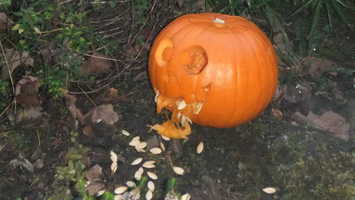
|

|

|
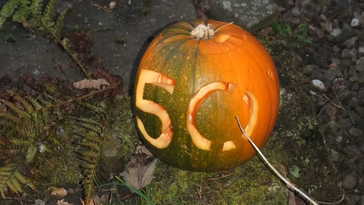
|
| For inventive use of pumpkin innards | For scare value. | Wins the car grill look-alike prize. | For age-appropriateness. |
Buffalo Wings
side snack fowl
It's hard to tell exactly which is the authentically original buffalo wing sauce.
My American friend Becky votes for the hard-to-find Original Anchor Bar Buffalo Wing Sauce , but on the other hand Costco stocks Frank's.
So Frank's it is!
My American friend Becky votes for the hard-to-find Original Anchor Bar Buffalo Wing Sauce , but on the other hand Costco stocks Frank's.
So Frank's it is!
Rumour has it that the original dressing was actually just Frank's (or any Cayenne hot sauce like Durkee's or Tabasco) and butter anyway.
Just like the recipe below.
Yeehaw!
If you're doing these on the barbecue then you can just hand out freezer bags with the bottled sauce
so people can fill the bags and do their own dipping and coating.
Just like the recipe below.
Yeehaw!
Serves a bar-full
Ingredients
- hundreds of chicken wings
- fat for deep-frying
- a cayenne pepper hot sauce
- butter
- blue cheese dip or ranch dressing
- celery
Dry the chicken wings thoroughly. You can season them if you like, though this seems heretical to some.
Heat the oil to 375-400°F (190-200°C); a cube of bread will sizzle when dropped in.
Fry the chicken wings until crisp and golden: about 10 minutes.
It's traditional to serve the dip with a stick of celery. Go figure.
Heat the oil to 375-400°F (190-200°C); a cube of bread will sizzle when dropped in.
Fry the chicken wings until crisp and golden: about 10 minutes.
You could also try
double-frying the wings for extra crispiness,
frying at a lower temperature (250°F/120°C) first until they are lightly coloured, then finishing in hotter oil.
Meanwhile heat up your favourite buffalo wings sauce with between half and an equal volume of butter until the butter melts.
I'd go with an equal volume :)
If you like you can also add extra seasonings (herbs, Worcestershire sauce, chilli powder, paprika, hot sauce, vinegar, garlic powder or anything else you fancy) and simmer the mixture for a while.
When the wings are ready toss them with the sauce in a bowl.
You can also simmer them up in the sauce if you prefer.If you like you can also add extra seasonings (herbs, Worcestershire sauce, chilli powder, paprika, hot sauce, vinegar, garlic powder or anything else you fancy) and simmer the mixture for a while.
It's traditional to serve the dip with a stick of celery. Go figure.
